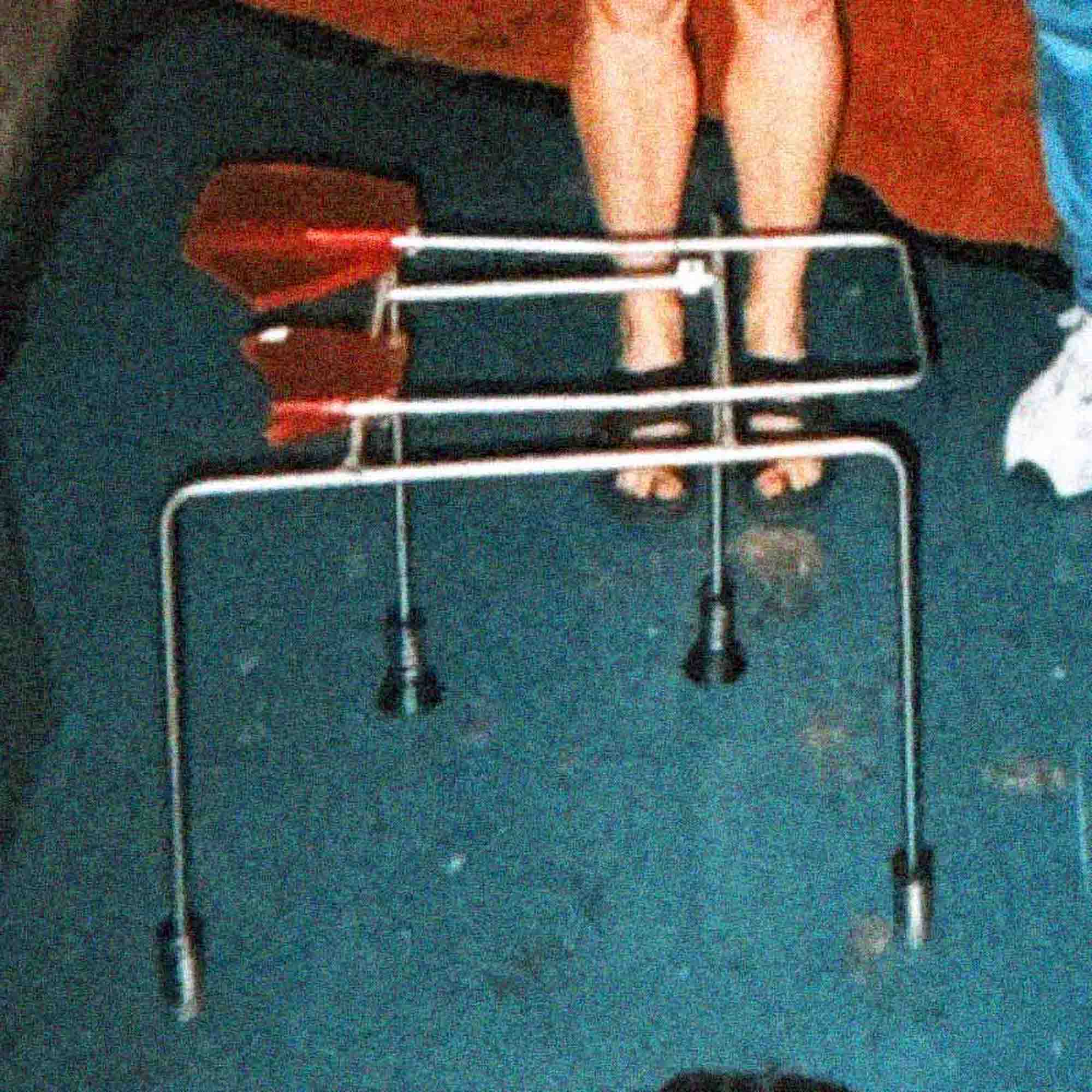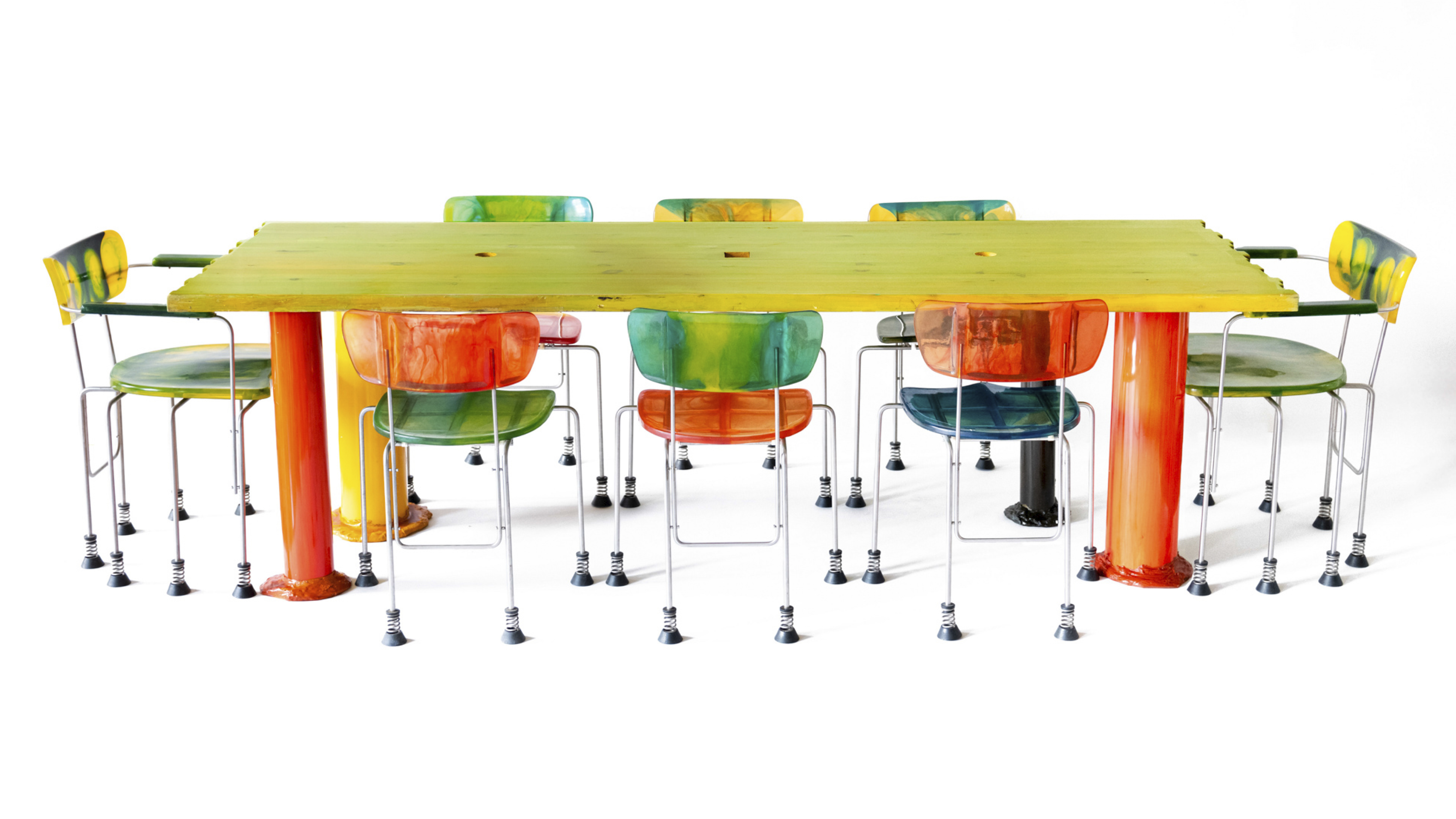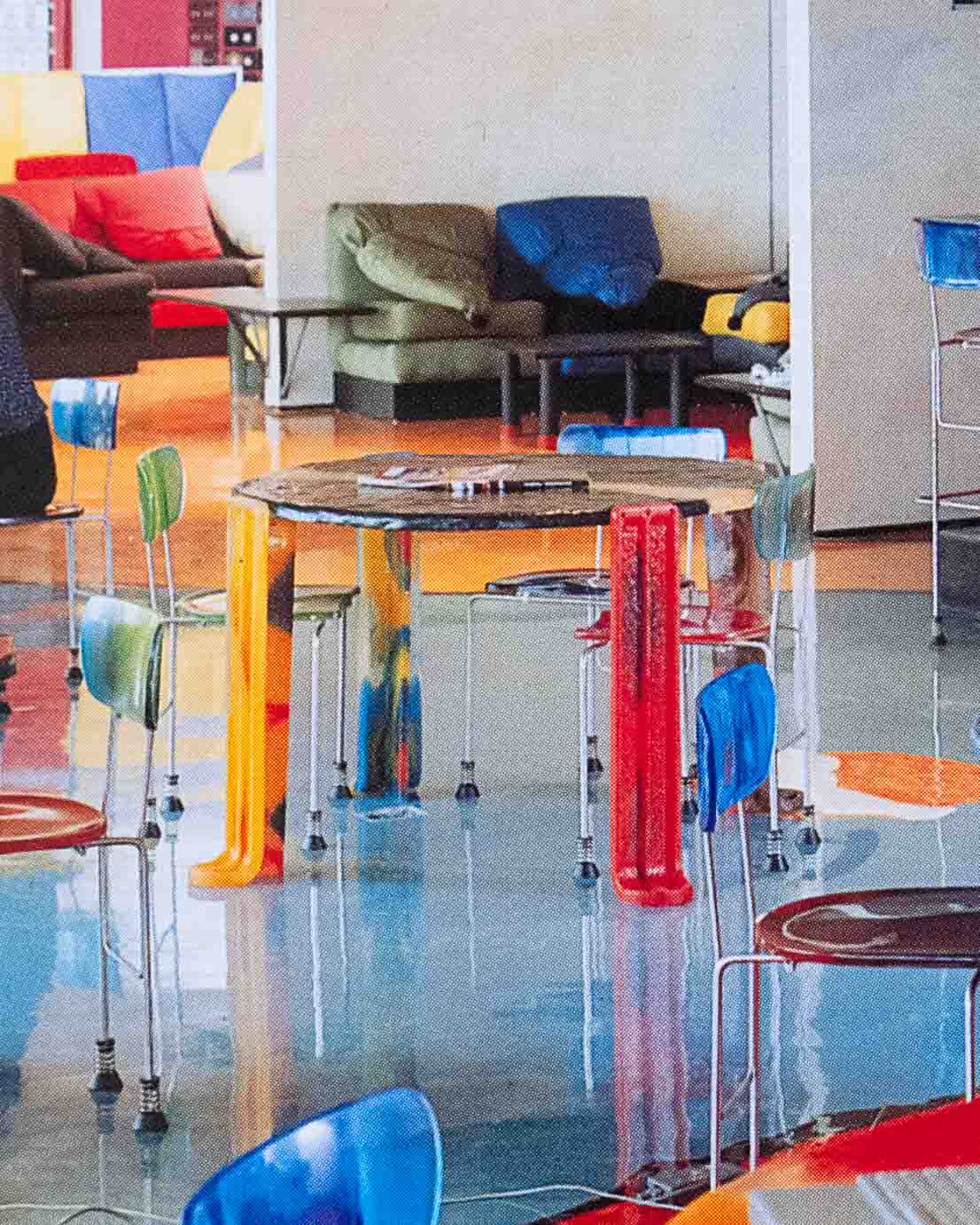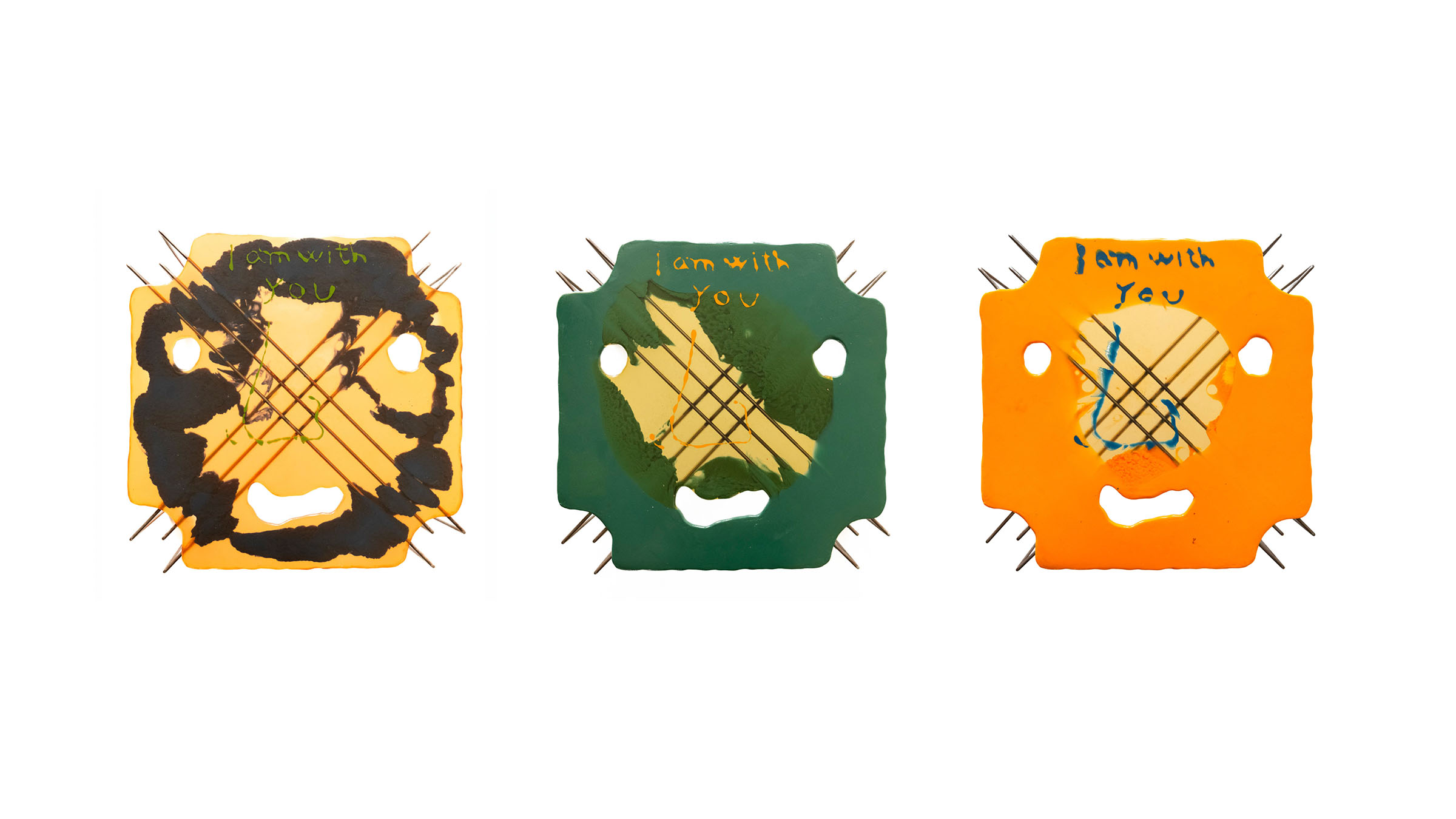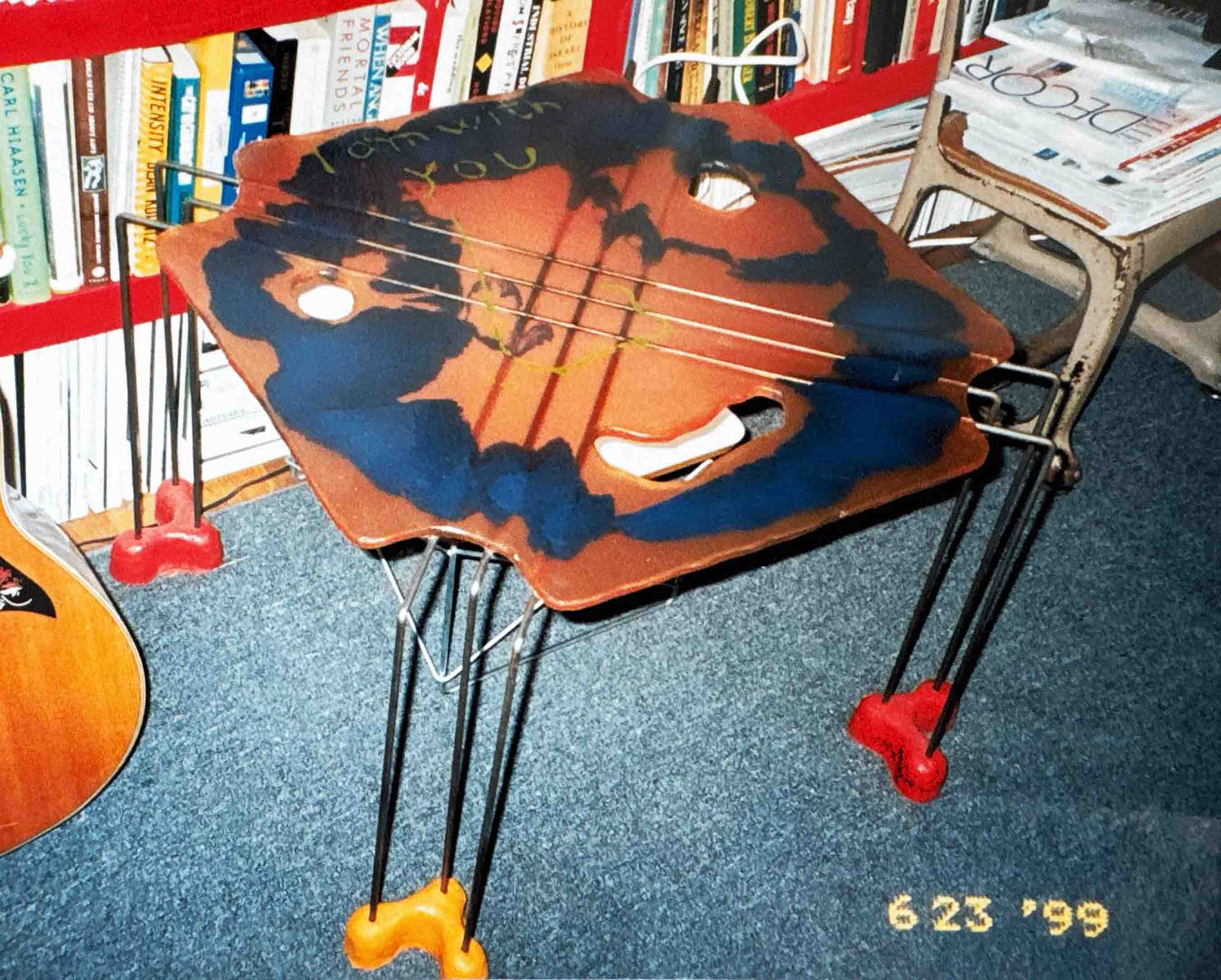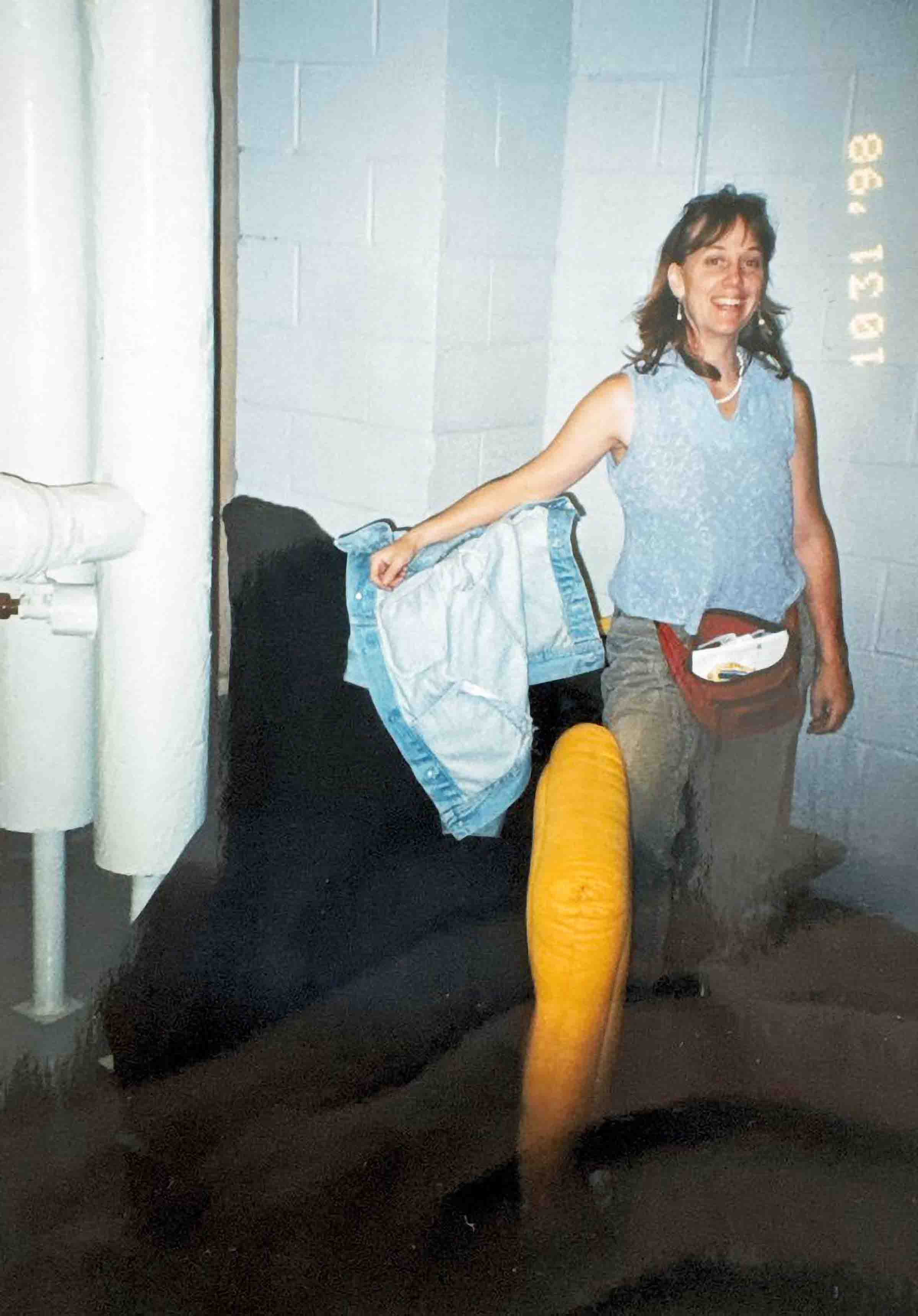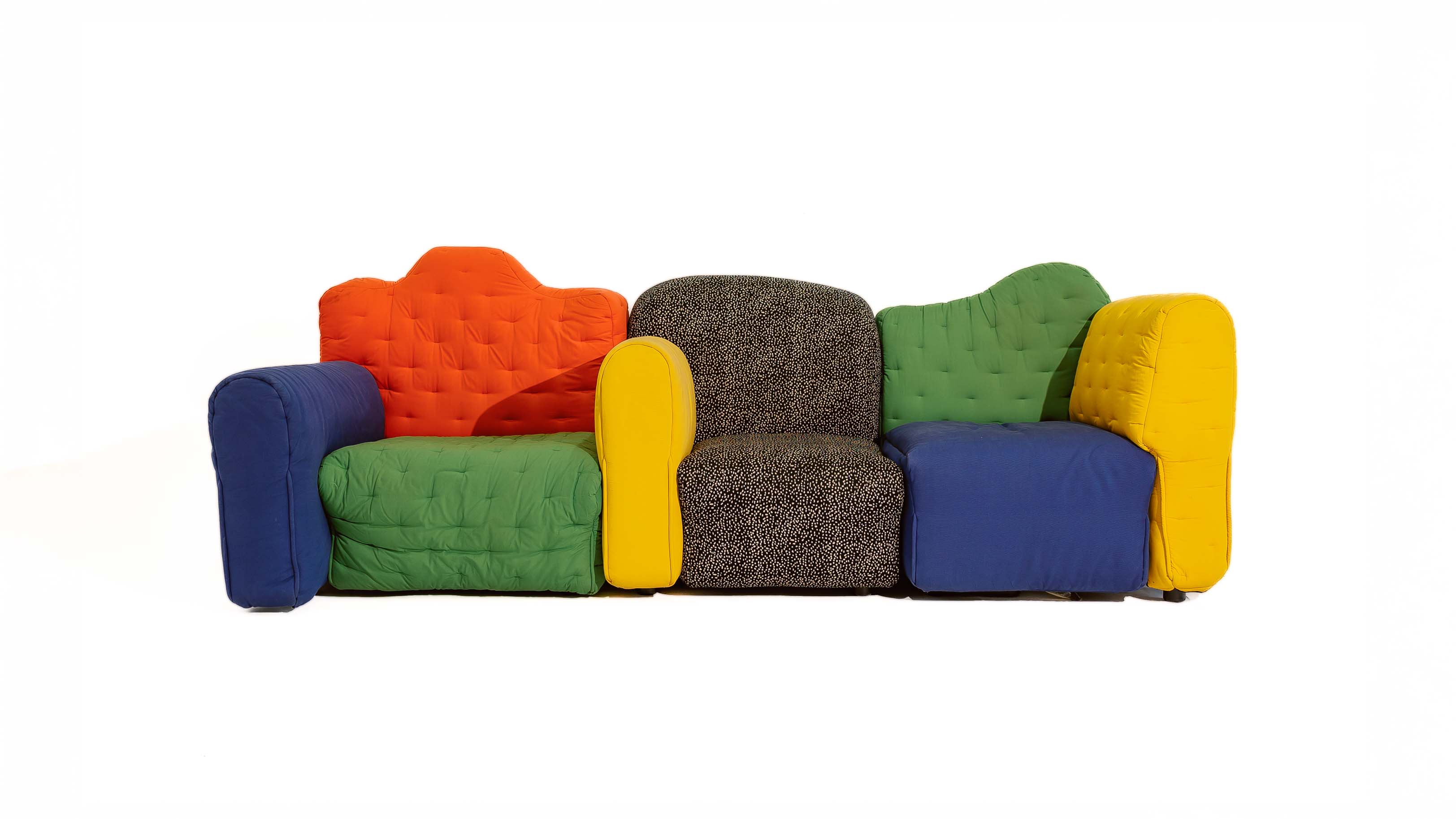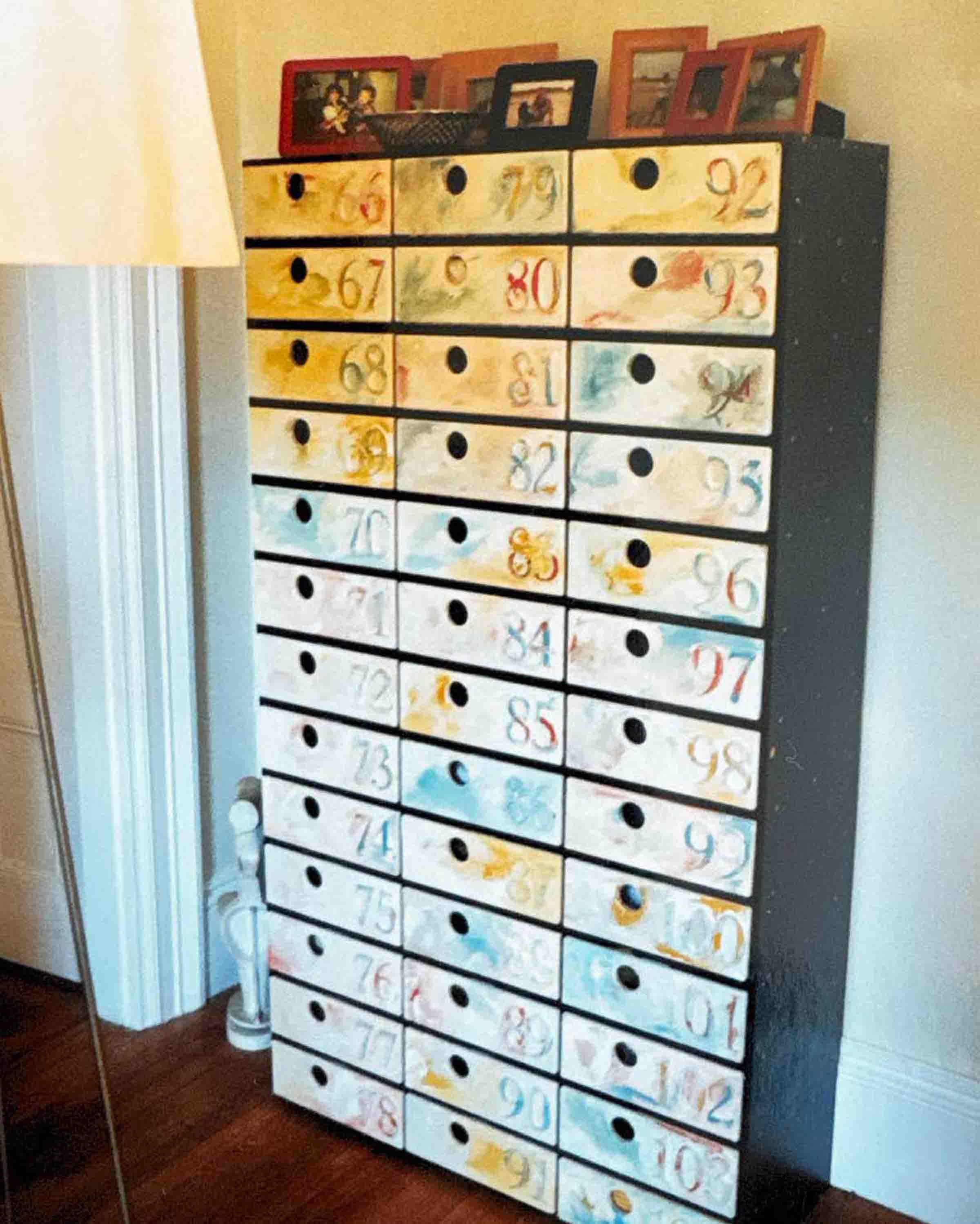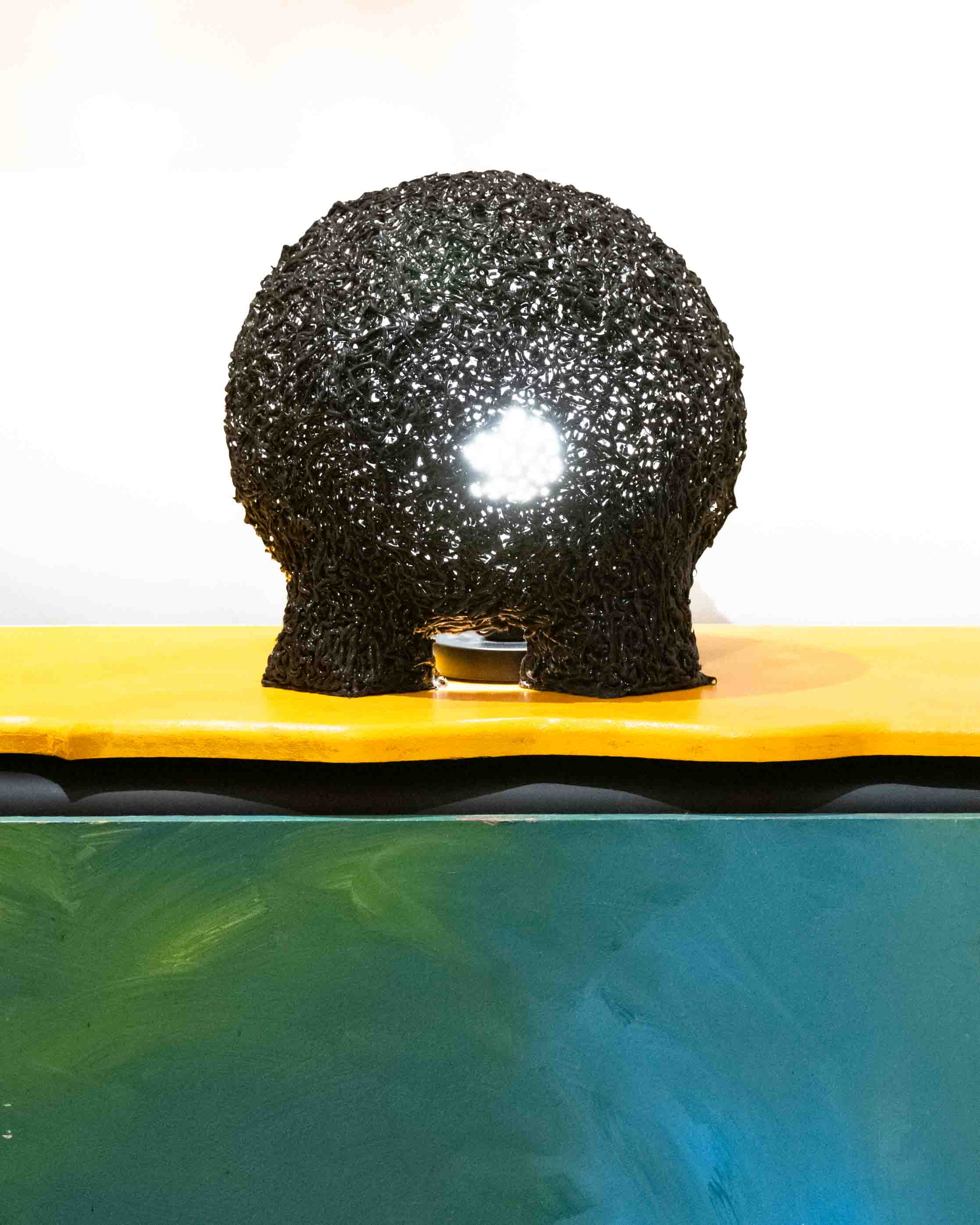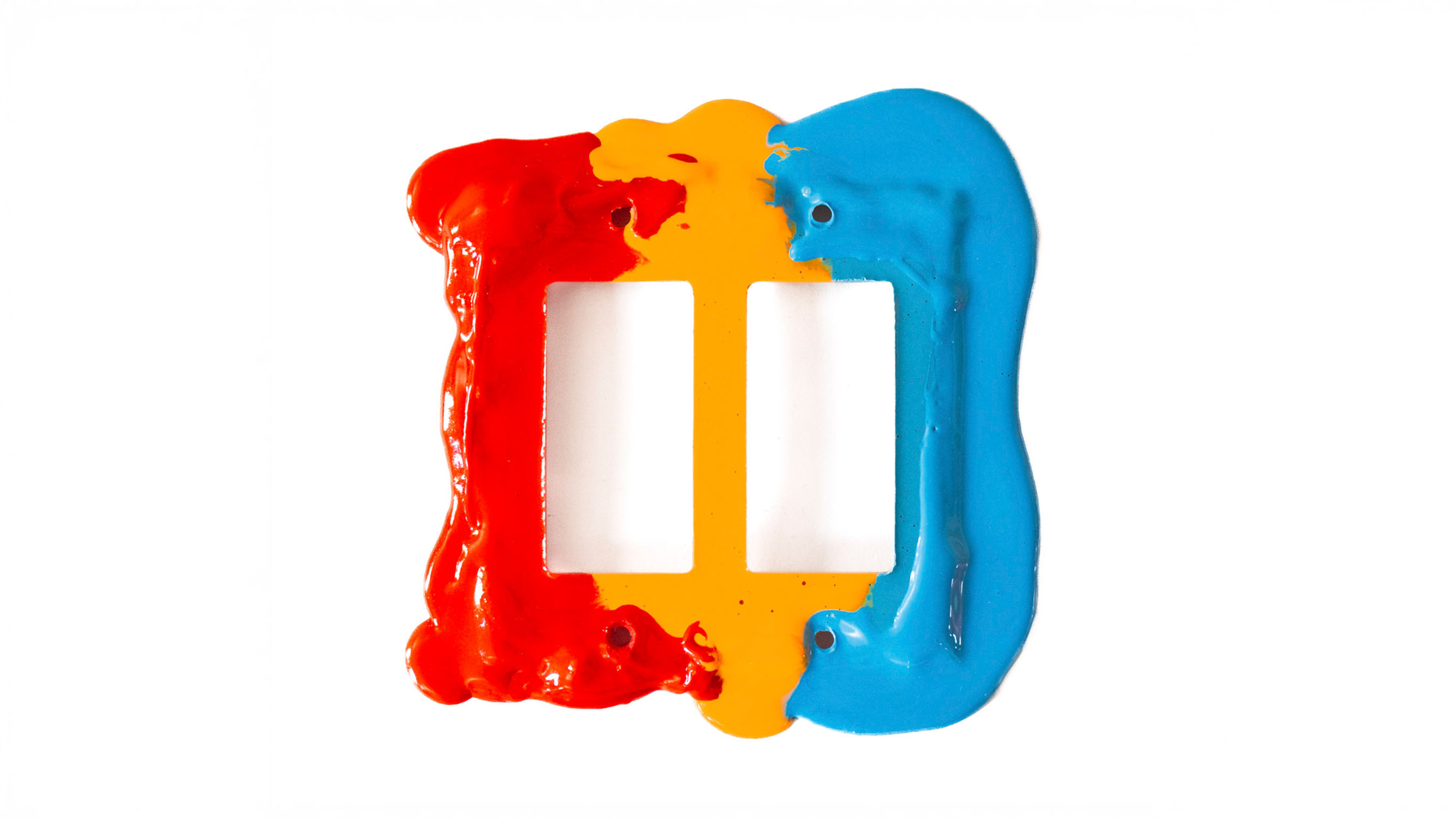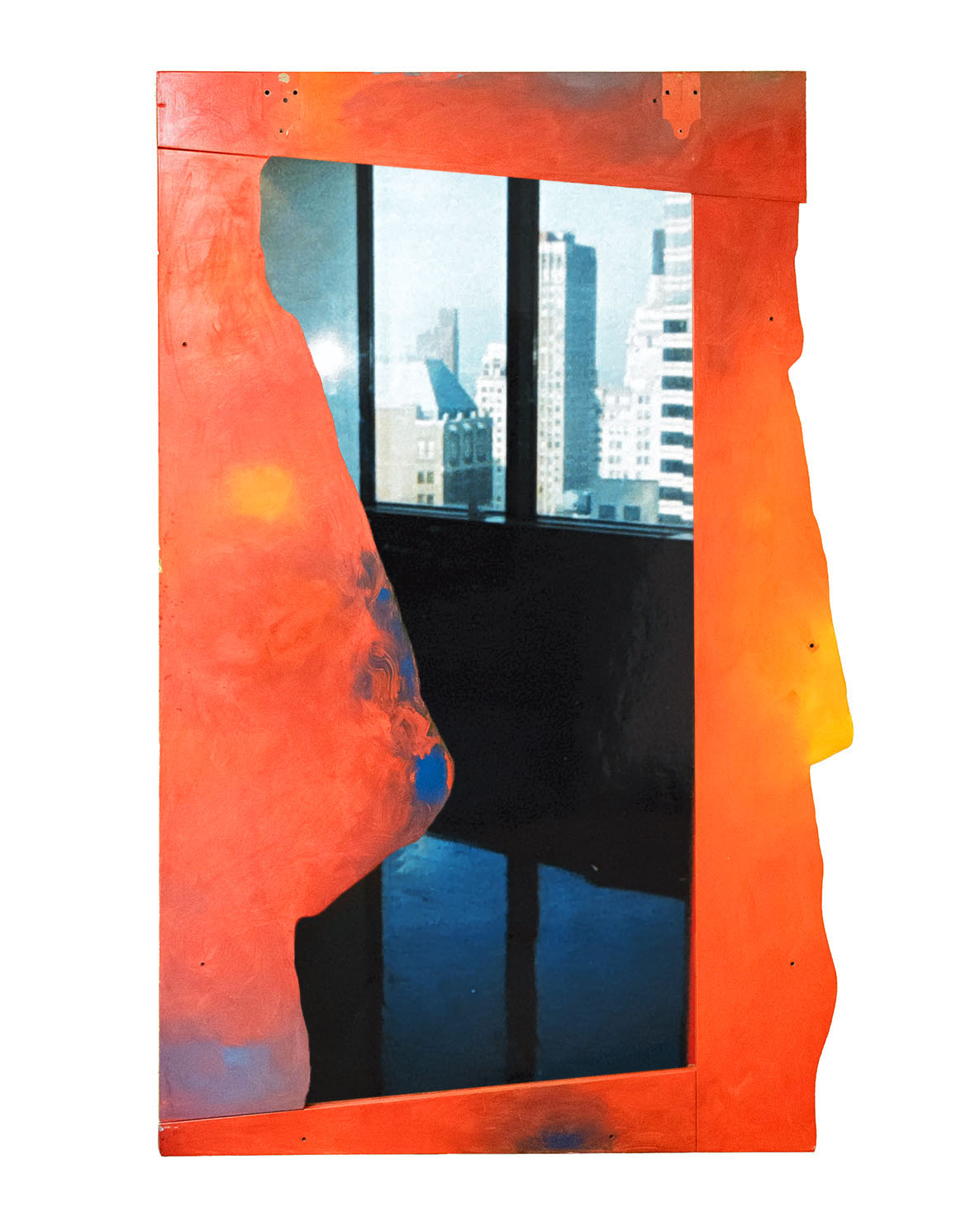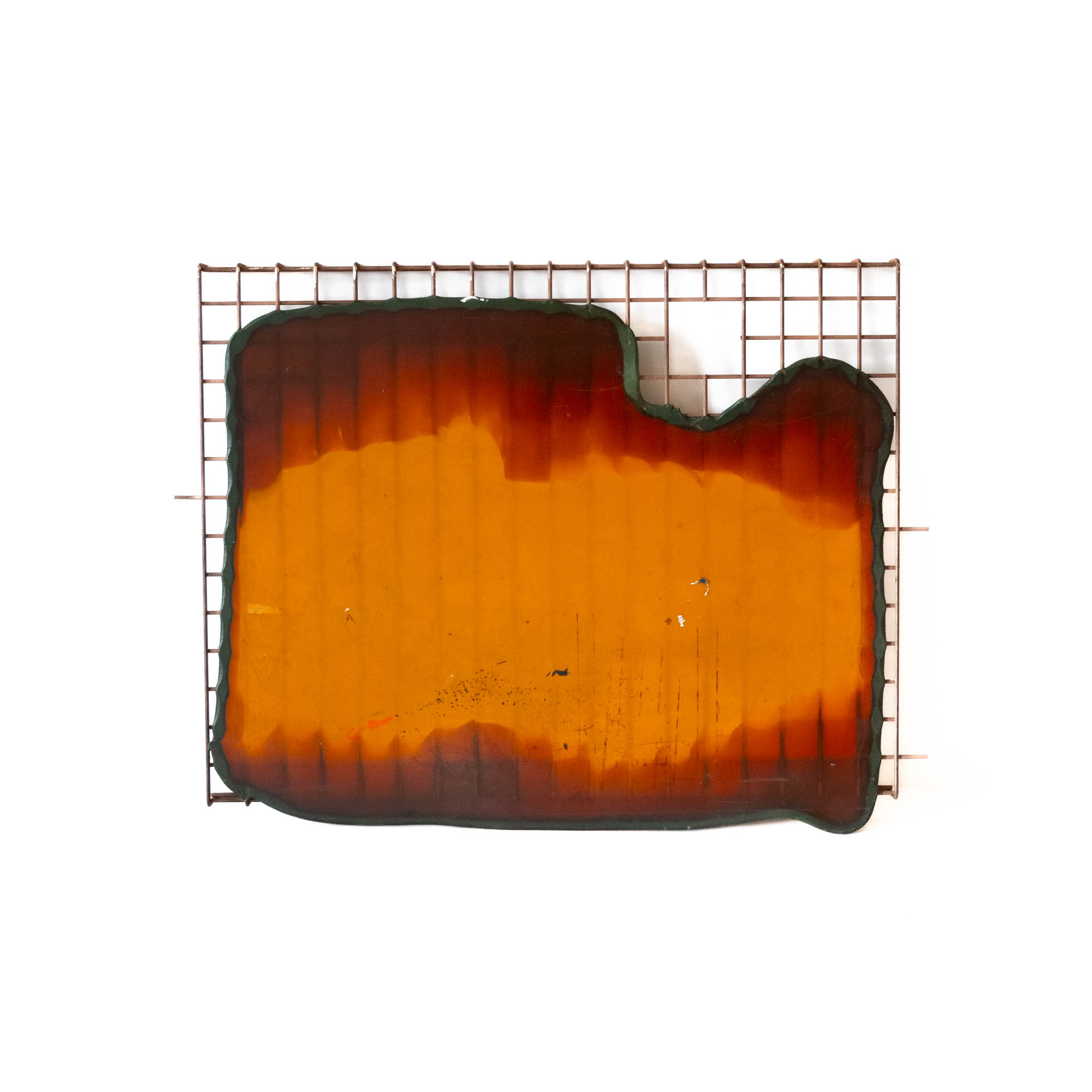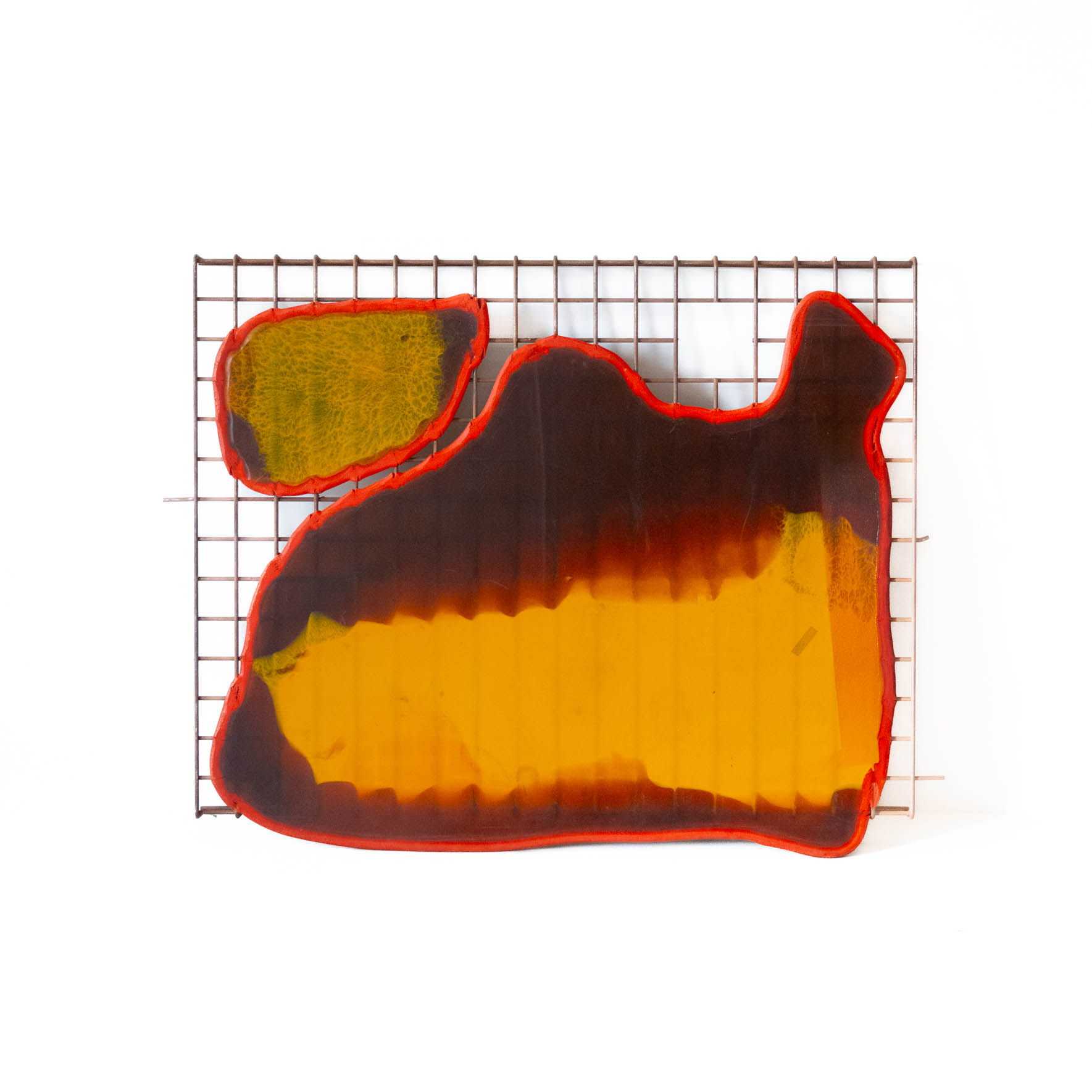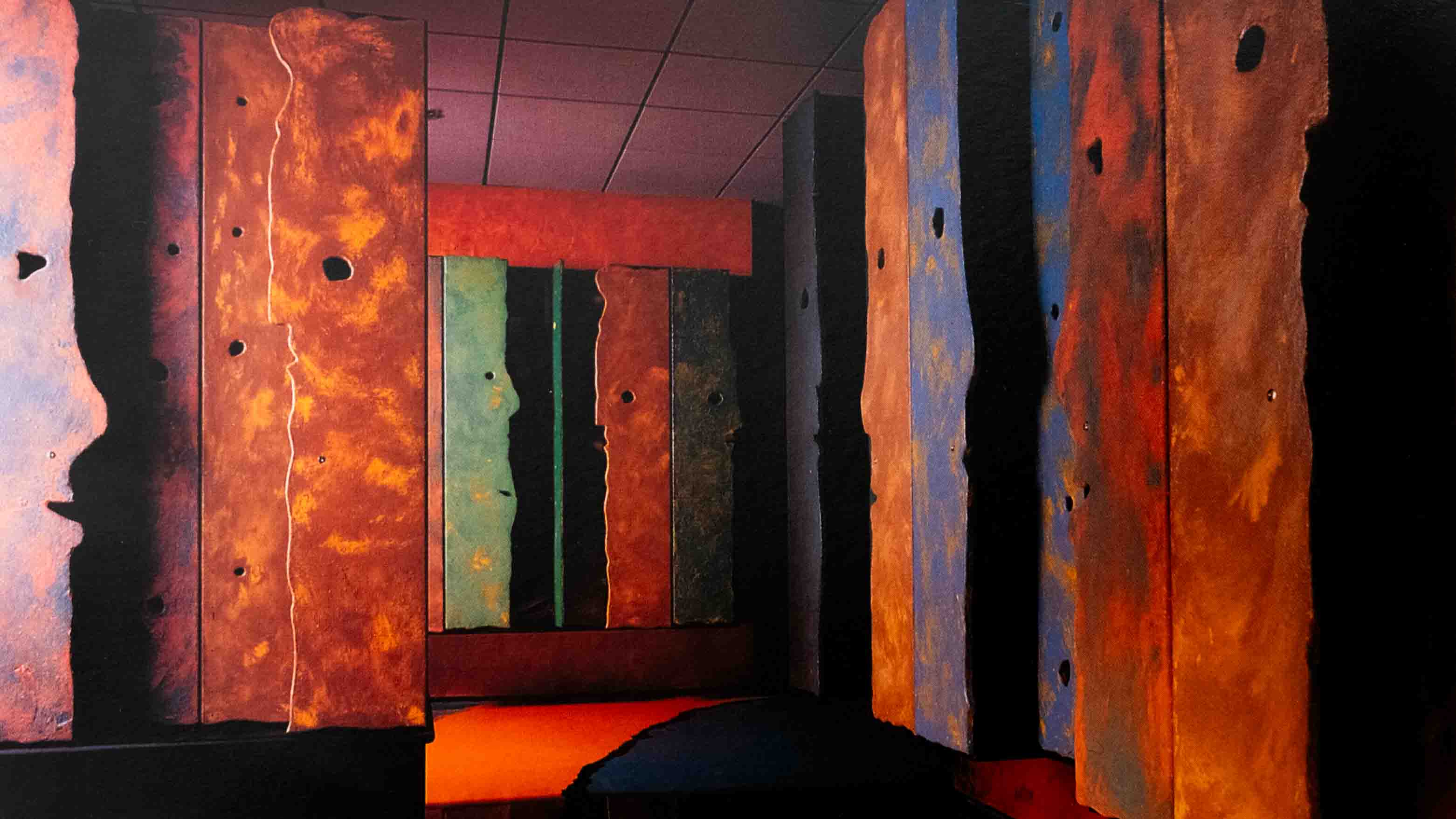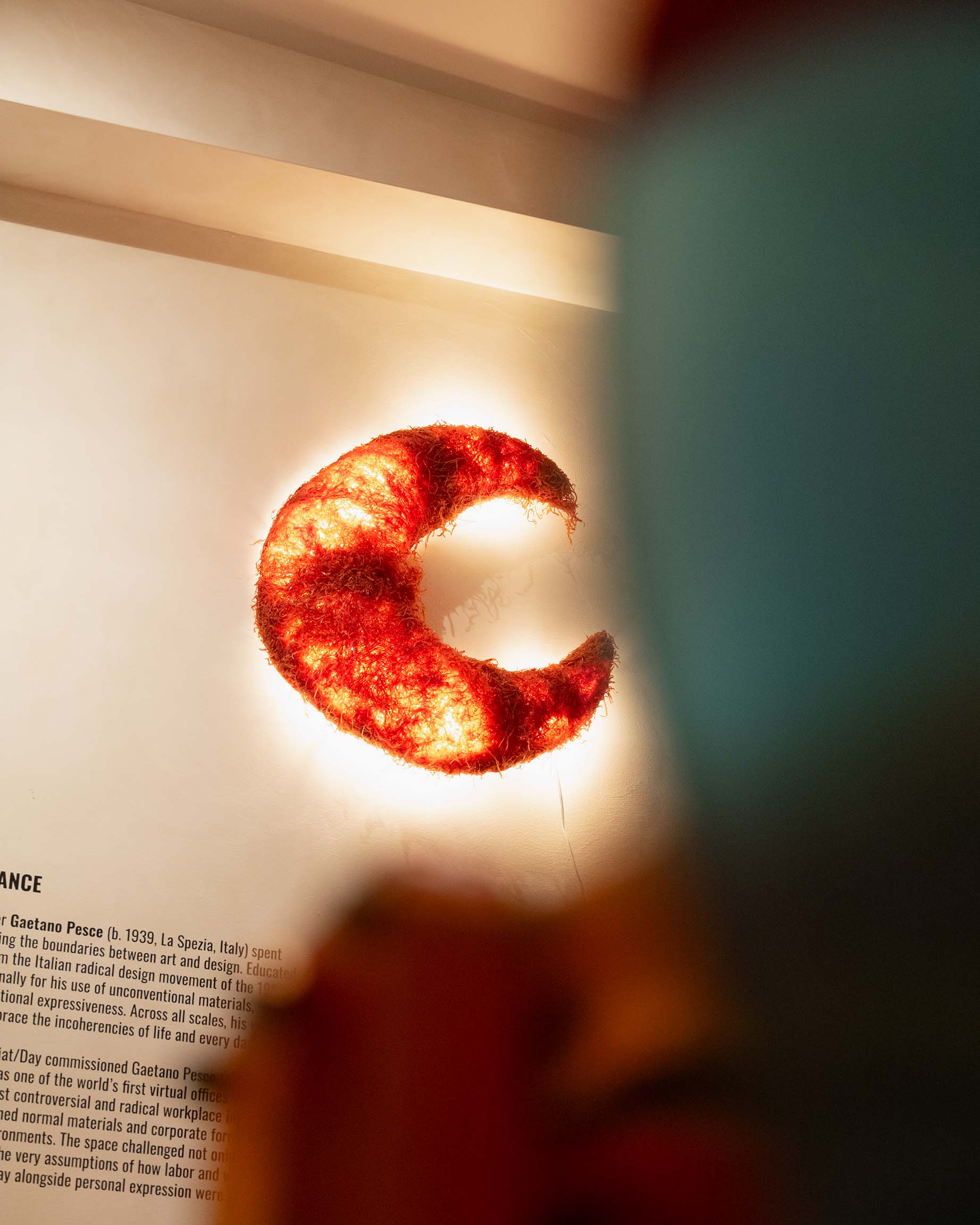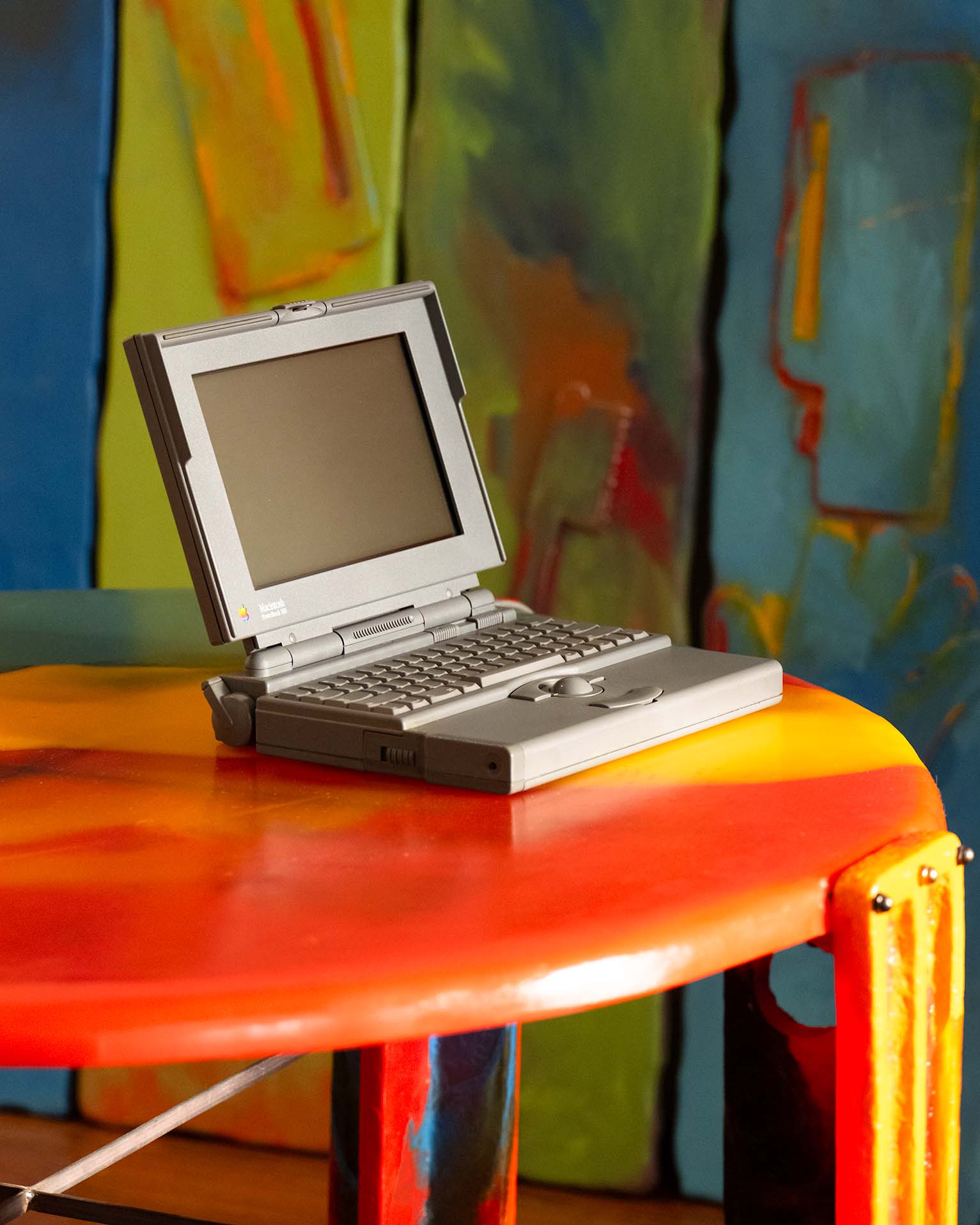HISTORY
In 1994, at the dawn of the internet age, Gaetano Pesce transformed TBWA/Chiat/Day’s New York headquarters into the world’s first virtual office — a bold experiment in paperless, mobile work inside of a shared space. It emerged during a moment of both optimism and uncertainty about what computers and the internet could mean for daily life, making it one of the most radical and influential workplace designs in history. During the age of remote work, return-to-office mandates and generational burnout, this project is relevent now more than ever.
Presented by Sweeterfat
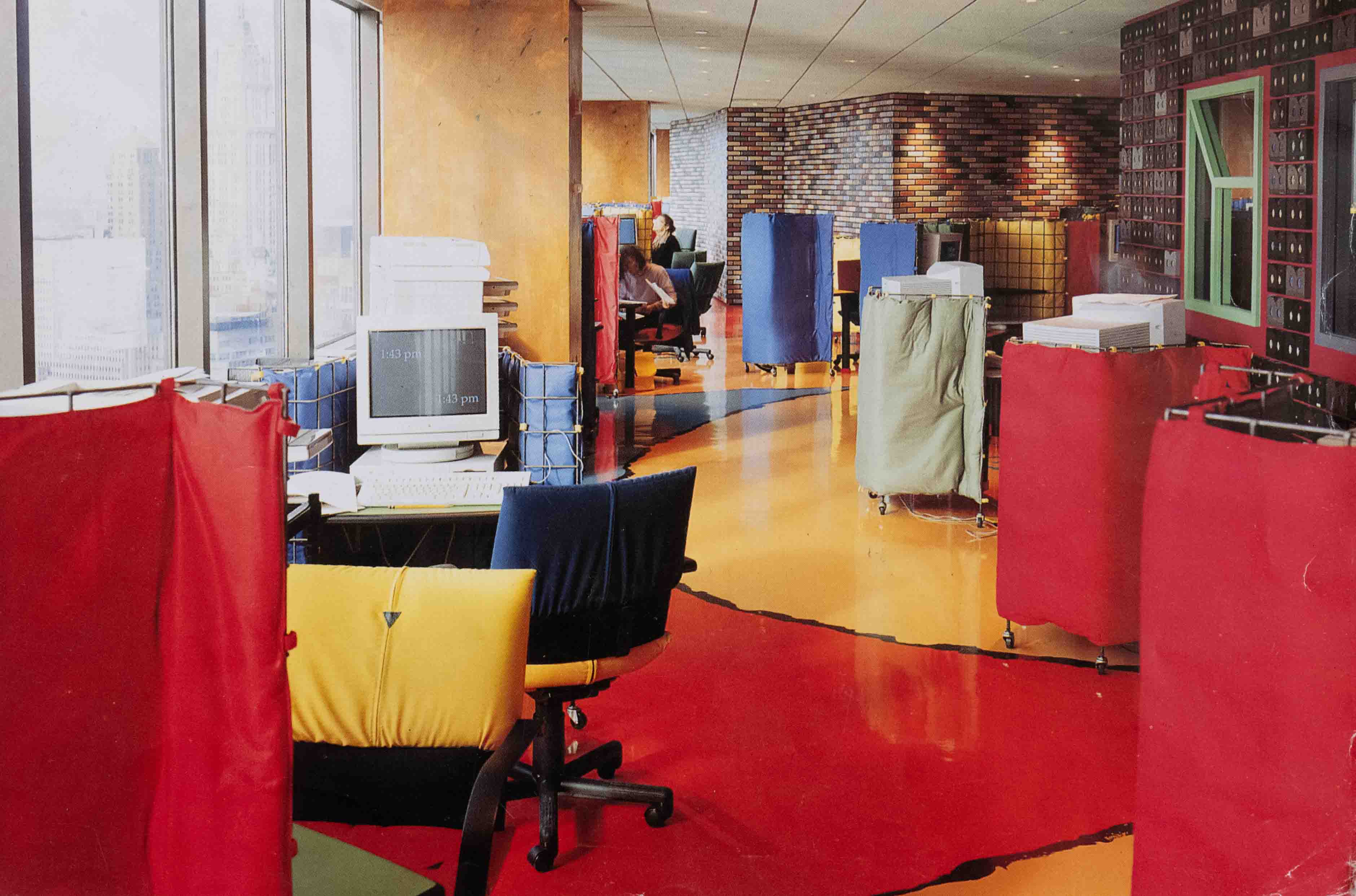
Why Gaetano Pesce's 1994 Chiat/Day Office Was a Radical Shift in Workplace Design:
The tale goes that Jay Chiat was skiing in Telluride when he had a vision of a paperless office. In the very early stages of a new digital world (wide web), this unorthodox concept was soon to become the world’s first virtual office — and only Gaetano Pesce’s radical vision was fit for the task.
The office became such a landmark destination that the agency began scheduling daily tours of the space.
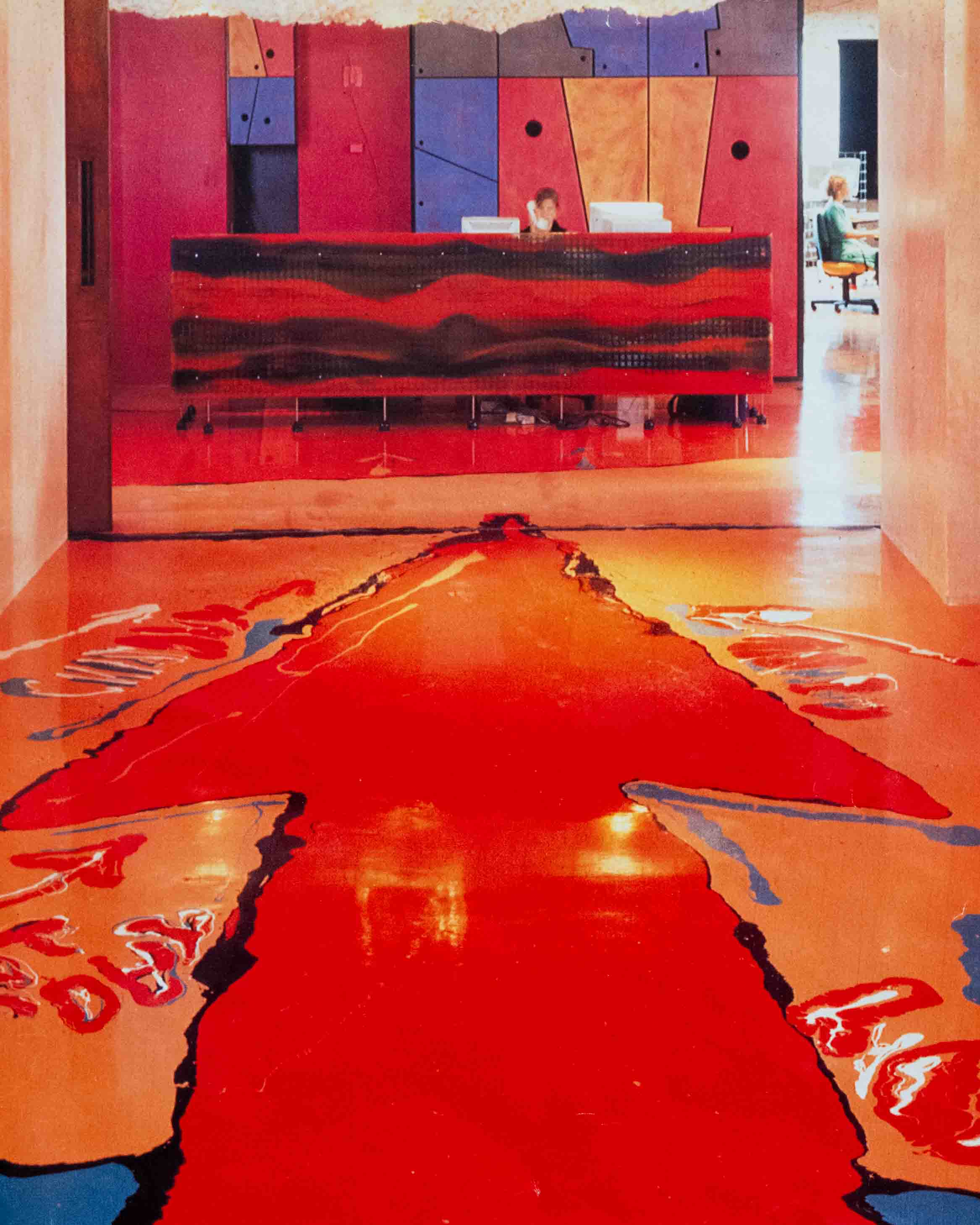
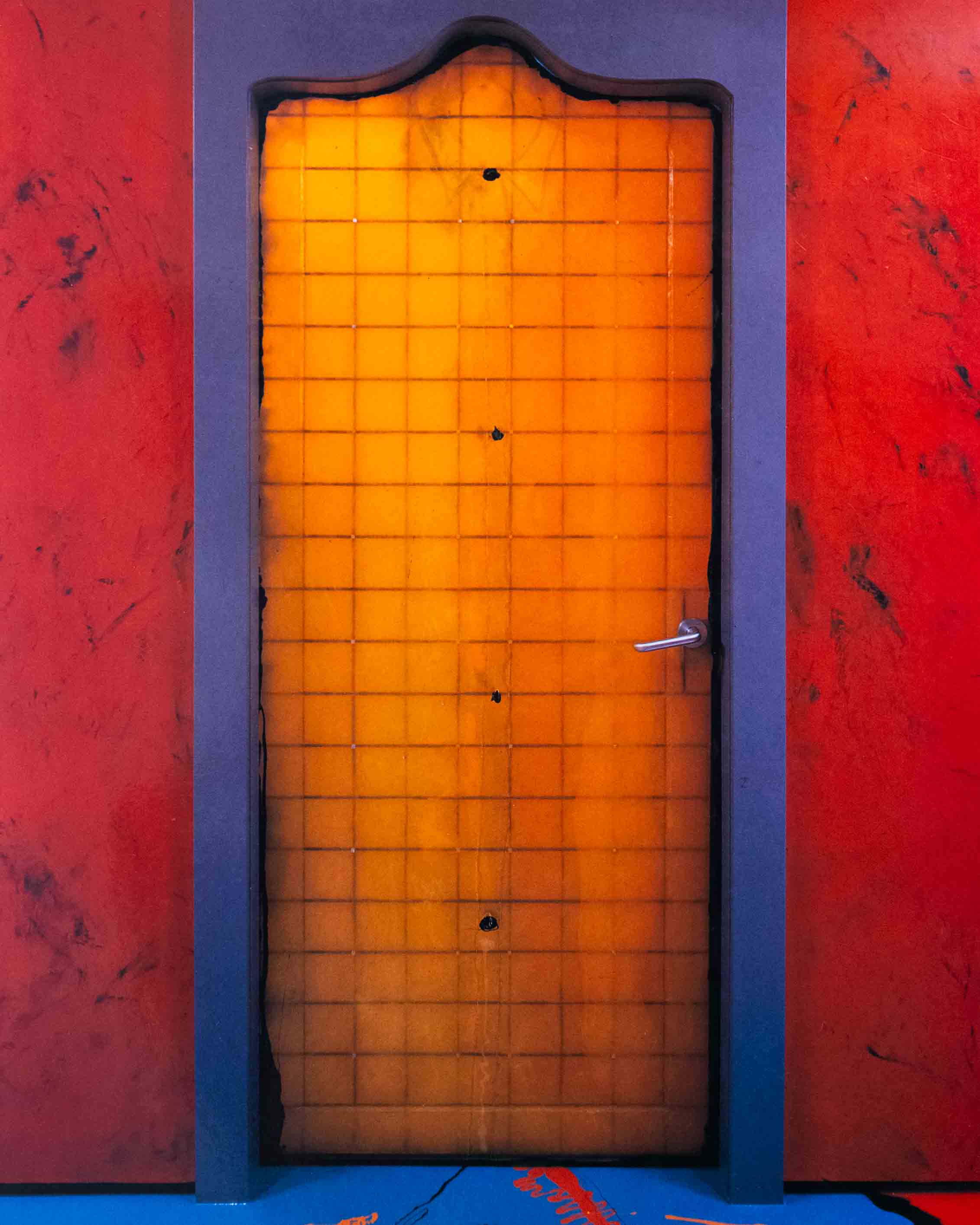
Resin Doors & Resin Floors:
Almost 60,000 square feet of hand-poured resin set the backdrop for... even more resin! Seen above is the resin door to project room No. 5 which shows the subtle outlines of a collared button down shirt. Symbols like this appear throughout the office, signs that Pesce played with the ideas of traditional corporate spaces while entirely dismantling them.

No Assigned Desks & No Assigned Offices:
The design hinged on another key concept: there were no assigned desks or offices. Responding to the desire for a paperless space, Pesce’s answer was “you don’t need the office.” And so, one of the world’s first community work spaces was created.
At the time, Jay Chiat insisted that the majority of his employees were proud to be a part of the project. He said, “I can tell that this is pretty good because a lot of people have brought their mothers up to see the place... (smiling like a guy who’s about to close a deal) that’s the real test: showing your mom your office when you don’t have an office... think about it.”
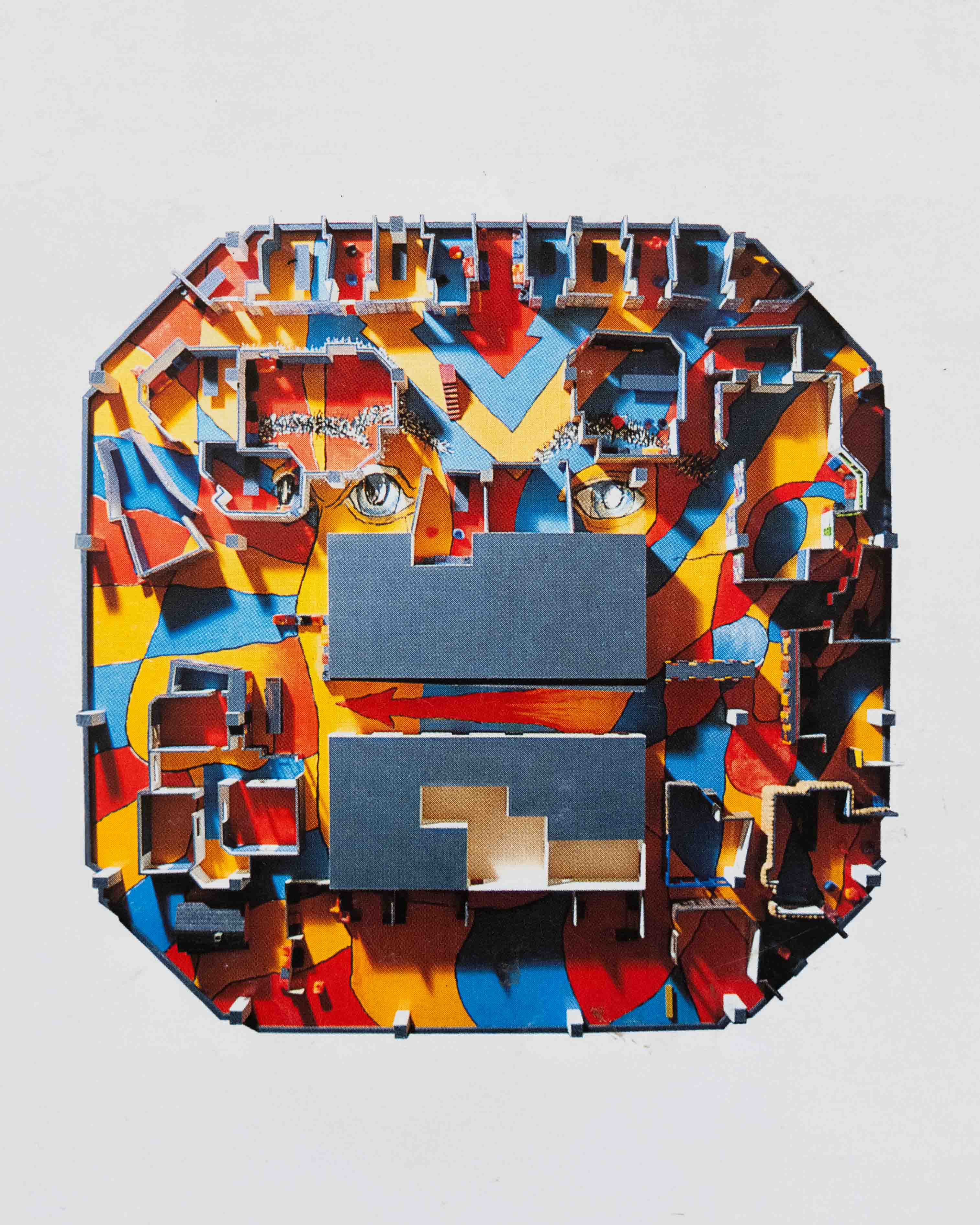

Architectural Model of the Office:
(Image 1) Scale model created by Gaetano Pesce of the floorplan for the TBWA/Chiat/Day office. This unique perspective gives us a closer look at Pesce’s process, revealing one immense figure peering up at us through the resin floor. Focusing in on the small details and the larger ones, we can see many moments of thoughtfulness that reveal human gestures and presence.
Mouth Wide Open:
(Image 2) From this open-mouth window, sculpturally formed by intricate molding techniques, Gaetano Pesce creates a portal to the equipment center where employees of TBWA/Chiat/Day would go each morning to retrieve their 1990s technology. It has been reported that approximately $6 million was spent acquiring the early generation Macintosh Powerbooks, which were available through this window.

Hop-Scotch During Your Lunch Break:
Many employees loved the space and many found it very hard to work in. Some went as far to describe it as “working inside of a migraine.” Yet, all of them were able to play hop-scotch, enjoy the sturdiness of a steel desk + the wobbliness of a resin one, and take full advantage of the creative potential (only IF they understood the possibility - see below).

Q1:
Do you think the open office went too far?
GP:
No, no, there is never too far.
Q2:
What would you say to somebody who said I worked in this office and it was beautiful, but I couldn't get any workdone?GP:
Did he understand the possibility, the creativity?1998: The Demolition
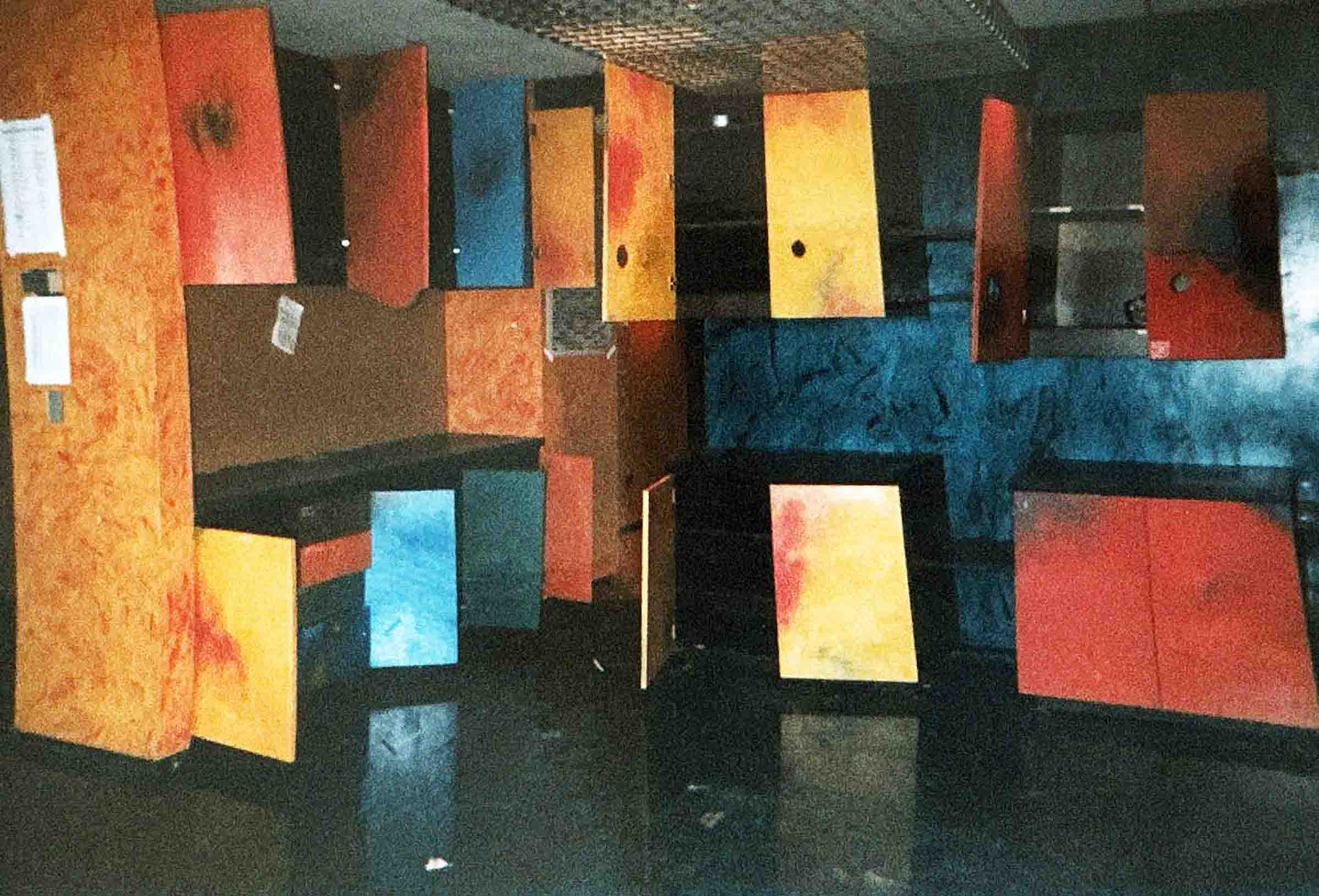
In 1998, one collector was lucky enough to stumble upon the office as it was being closed down. As jackhammers were taken to the resin floors and many pieces were destroyed, lost, or brought to nearby warehouses, he planned two trips to save everything he could. These visits, which took place in October/November of 1998, are the reason the below pieces are available for presentation & acquisition today - over 27 years later.
Salvaging what was left:
Pictured is a broken back of a 4 legged Broadway chair designed by Gaetano Pesce for the TBWA/Chiat/Day office. While the Broadway chairs are normally durable designs, illustrated by their use thorughout the office, when the space was being torn down there was little care taken to the objects and ensuring their safety. Few people understood the true value of their history, and the important story they told.
This chair was just one of countless items that were unfortunately destroyed and lost in the process of closing the office.

Many Stories Waiting To Be Told:
The faces looking back from many of Gaetano Pesce’s designs remind us that we are not alone. In a corporate space, living space, public space, and private space - Pesce’s objects hold spirits within them that extend their hands and ask us if we wish to take them. The process of answering this question is left for each of us to decide.
Prototype Conference Table
Gaetano Pesce, 1994, for TBWA/Chiat/Day NYCPrototype conference table created by Gaetano Pesce for the 1994 TBWA/Chiat/Day office. This table was rescued in 1998 during the demolition of the space and held in private collection until now. Pictured above with the 543 Broadway series - four legged and eight legged Broadway chair variations.
More info

Conference Table
Gaetano Pesce, 1994, for TBWA/Chiat/Day NYCThe prototype conference table was created for one of the project rooms in the 1994 NYC office for TBWA/Chiat/Day. Each leg is a different size, color, and has a resin foot to match it. The table is 1 of 1 and was rescued in 1998 during the demolition of the office. It has been held in private collection until now.
More info
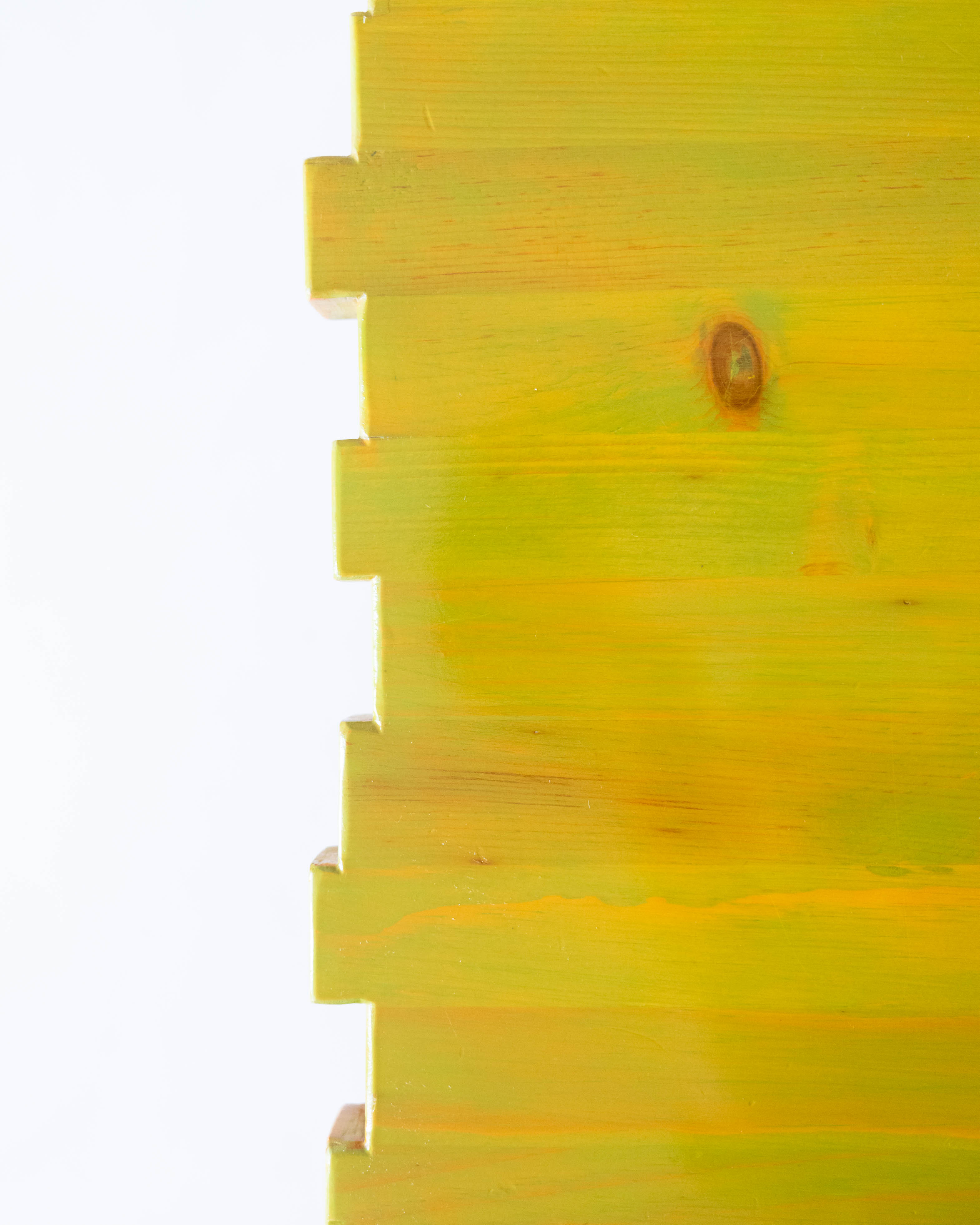
The Details
Conference table for TBWA/Chiat/Day NYC, 1994The stepped edges on this table are perhaps a brutalist-royere take, or they could also be a moment of perfect Pesce happenstance. Either one, the edges on this table are not as expected, neither are the legs, neither are the feet, and neither are the colors. Very much in the fashion of Gaetano Pesce, incoherence is in every detail.
More info
The Waffle Table: In The Office
AKA: Waffles in the Clubhouse
The “Clubhouse” was the community work area located off of the “Piazza” - it featured, as shown, a variety of Waffle Tables paired with 543 Broadway chairs in mismatched back and seat colors. The resin floors were just as bright as the resin tabletops. Also pictured is a first generation Macintosh Powerbook. These computers were part of the ‘cutting-edge’ technology that the office featured in order to accomplish the daring goal of creating a paperless workplace.

Waffle Table
Gaetano Pesce for TBWA/Chiat/Day, NYC, 19941 of approximately 10 tables created for the 1994 TBWA/Chiat/Day office, designed by Gaetano Pesce. Each design is unique, thanks to the hand poured resin which allows for painterly-like control. Pesce was known to use resin as a medium in of itself, altering the chemical formulas to create less/more rigid compositions.
More info

Waffle Mold
Waffle Table, Gaetano Pesce, 1994, TBWA/Chiat/Day NYCThe underside of the Waffle table shows why Gaetano Pesce chose a breakfast food for its name. The underside reveals the waffle-like shape and pattern of the mold, which would have been used to pour the resin into and modify the colors. The table is made entirely of resin except for the small metal ‘X’ brace underneath.
More info
I Am With You Tables, Trio
Gaetano Pesce for TBWA/Chiat/Day, NYC, 1994Each “I Am With You” table features a smiling face with its message hand-poured in resin above. This was a caring table inside of a corporate setting, something only Gaetano Pesce would dare to create. The cut outs on each face are completely identical, allowing the resin to be the distinguishable feature.
More info

Stackable
These are the only three tables known to exist and thankfully the trio was saved from the office before its demolition in 1998. They were split up from each other shortly after, but return now to be shown as a set. As seen above, they can be stacked together and the legs create a rainbow of color surrounding all the smiling faces.
More info

Details:
The metal legs on the “I Am With You” tables are made out of thin steel supports held together by an L-shaped rubber foot. In some ways these tables are rigid and in other ways they are not. There is strength where it is needed, allowing for the design to be usable as a table - but there is also flexibility in the way the rubber and the resin allow for the steel to bend.
More info
SEATING

Broadway Chair
Gaetano Pesce for TBWA/Chiat/Day, NYC, 1994“The springs on the feet are to give a sense of insecurity, there is insecurity in our reality, we see it in violence, there is economic insecurity, there is insecurity in our health... when you sit you do not feel secure that is like the reality of life.” (Gaetano Pesce)
More info

Broadway Stool
Gaetano Pesce for TBWA/Chiat/Day, NYC, 1994This Broadway stool was taken from the NYC headquarters of TBWA/Chiat/Day in 1998 when the office was being dismantled. It features a wonderful combination of red and blue colors, subtly mixing together. Rare opportunity to own a Broadway chair with special provenance, otherwise impossible to find.
More info
Broadway Chairs: In The Office
The 543 Broadway series was used extensively in the “Clubhouse” area (pictured). Although they might look fragile, these chairs withstand daily use with ease. The springs on the feet allow for a slight sway which creates a floating sensation.
We invite you to imagine yourself on the 38th floor in midtown Manhattan, looking over the NYC skyline with (sky) blue resin under your feet and tufts of white that look like clouds, rocking side to side on a Broadway chair.
Prototype Sofa
Gaetano Pesce for TBWA/Chiat/Day, NYC, 1994This prototype sofa was designed by Gaetano Pesce for the 1994 TBWA/Chiat/Day office in NYC, featuring three separate upholstered pieces with horned backs in varying colors. The fabric is a thick canvas-like cotton which was used for its durability throughout the office. This sofa is similar to the ‘Puffy’ chairs in that it bears the same hand-tied tufts, as seen above.
More info
The Prototype Sofa: In The Office
Pictured is the right-most piece of the prototype sofa, similar to the “Puffy” chairs in style. Each piece features tufted canvas upholstery in different colors with horned backs.
This photo is dated 10/31/1998, timestamping the first visit to the office where the initial pieces were searched for, loaded up into the van, and saved.
Although the sofa was sold early on, it now comes back full-circle to be reunited with its original owner and showcased alongside the other pieces it was adopted alongside.
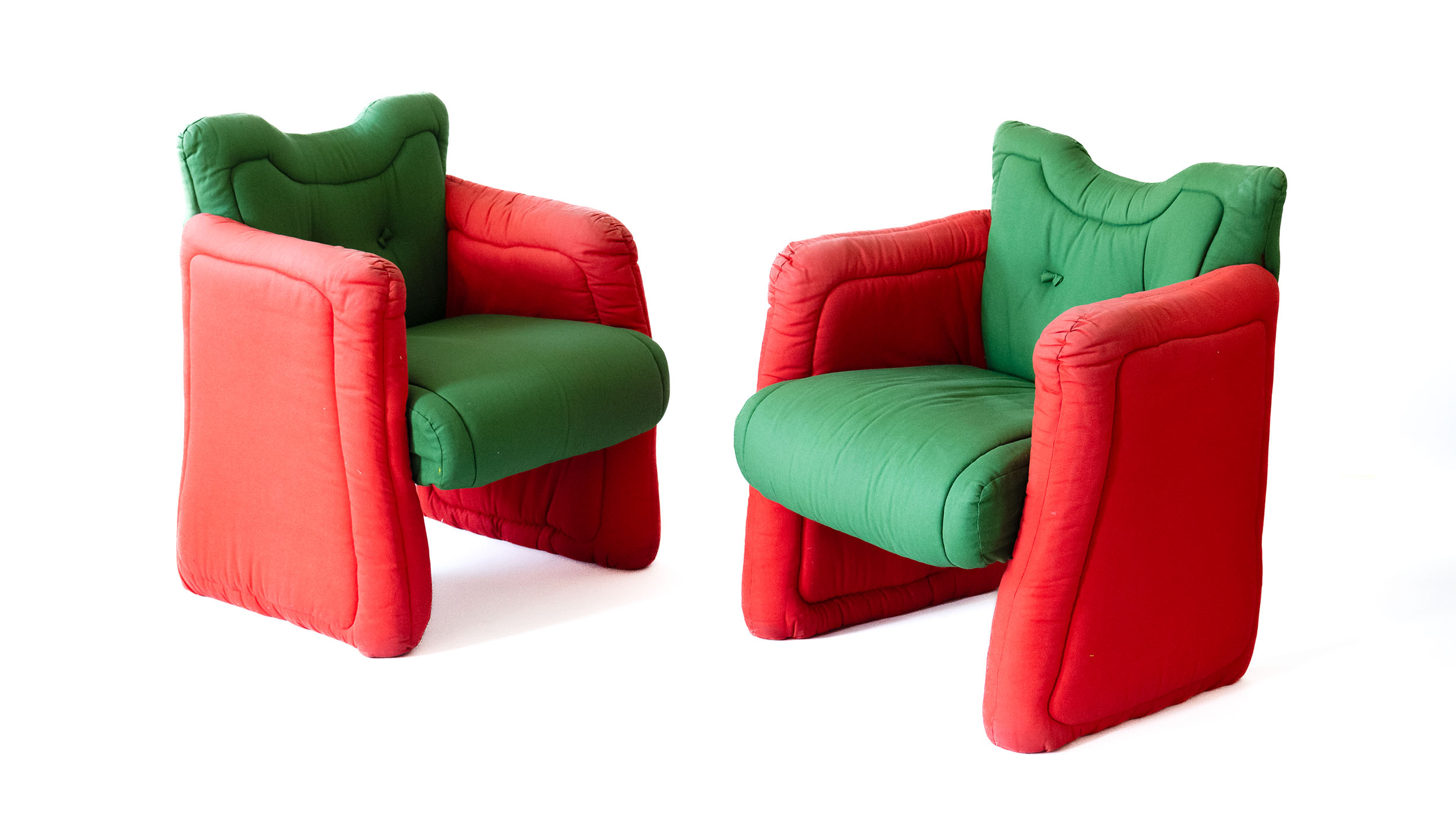
Puffy Chairs
Gaetano Pesce for TBWA/Chiat/Day, NYC, 1994The pair of ‘Puffy’ chairs designed by Gaetano Pesce. An enigmatic, laid-back design which notes a middle ground in Pesce’s practice between the fluid forms of resin and the rigid structures of steel. The upholstered chairs feature contrasting red and green colors with horned backs similar to the prototype sofa and hand-tied tufts throughout.
More info

Hidden Faces
Monday mood? The hand-tied tufts and stitches along the back of the Puffy Chair create a monotone face, perhaps slightly put-off. We imagine the individuals who did not enjoy working in the office sat in these chairs.
More info
Cannaregio Sofa
Gaetano Pesce for Cassina, original upholstery, Italy, c.1987An iconic and early design of Gaetano Pesce, the Cannaregio Sofa is a playful design which can be configured modularly. Therefore, organic and changing forms make up the shape of the sofa and also the experience of the design. Pieces can be used as individual seats or as a full unit, reorganized and moved around the space at will. This example features the original upholstery and original Cassina tags.
More info
543 Broadway:
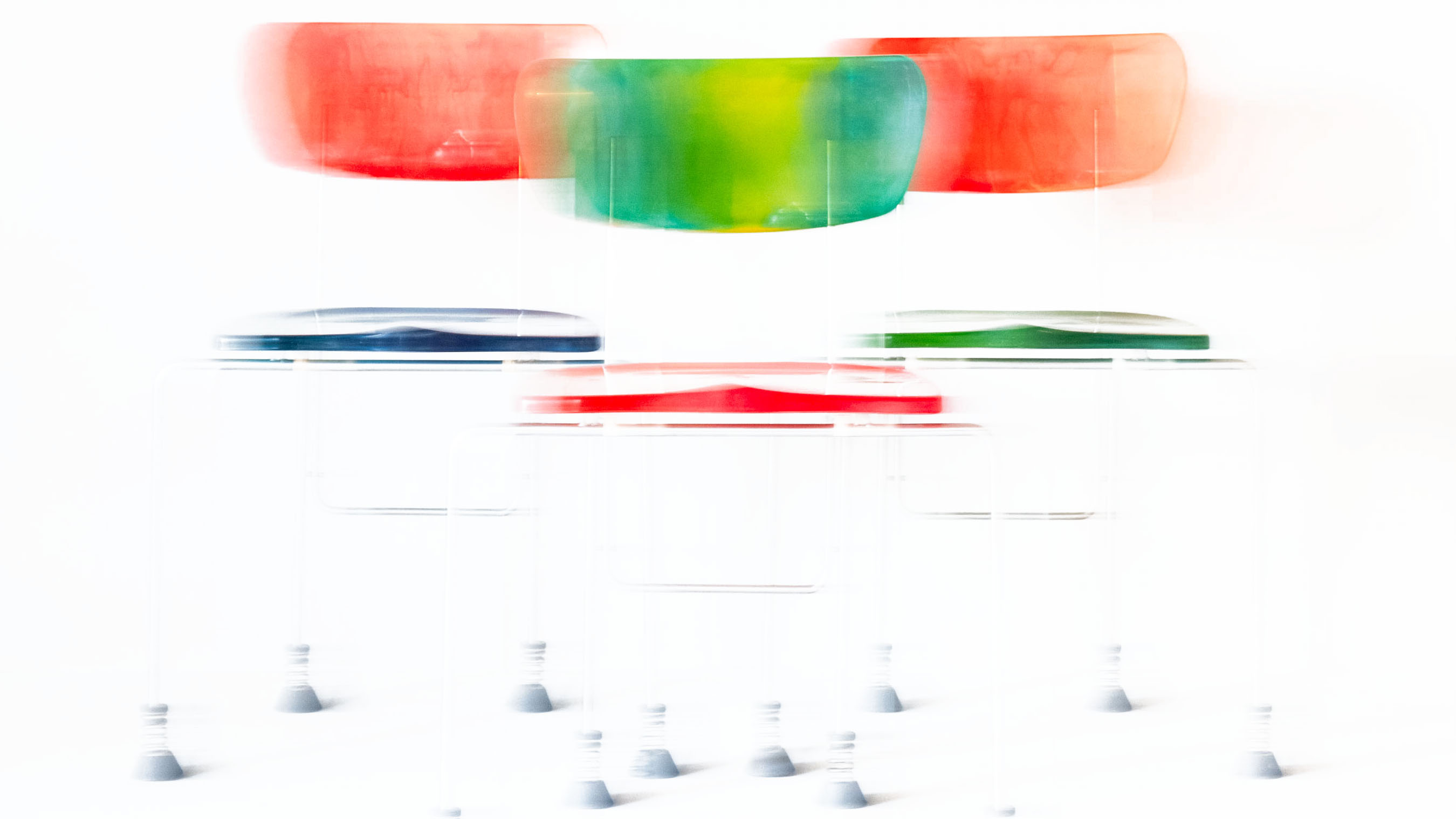
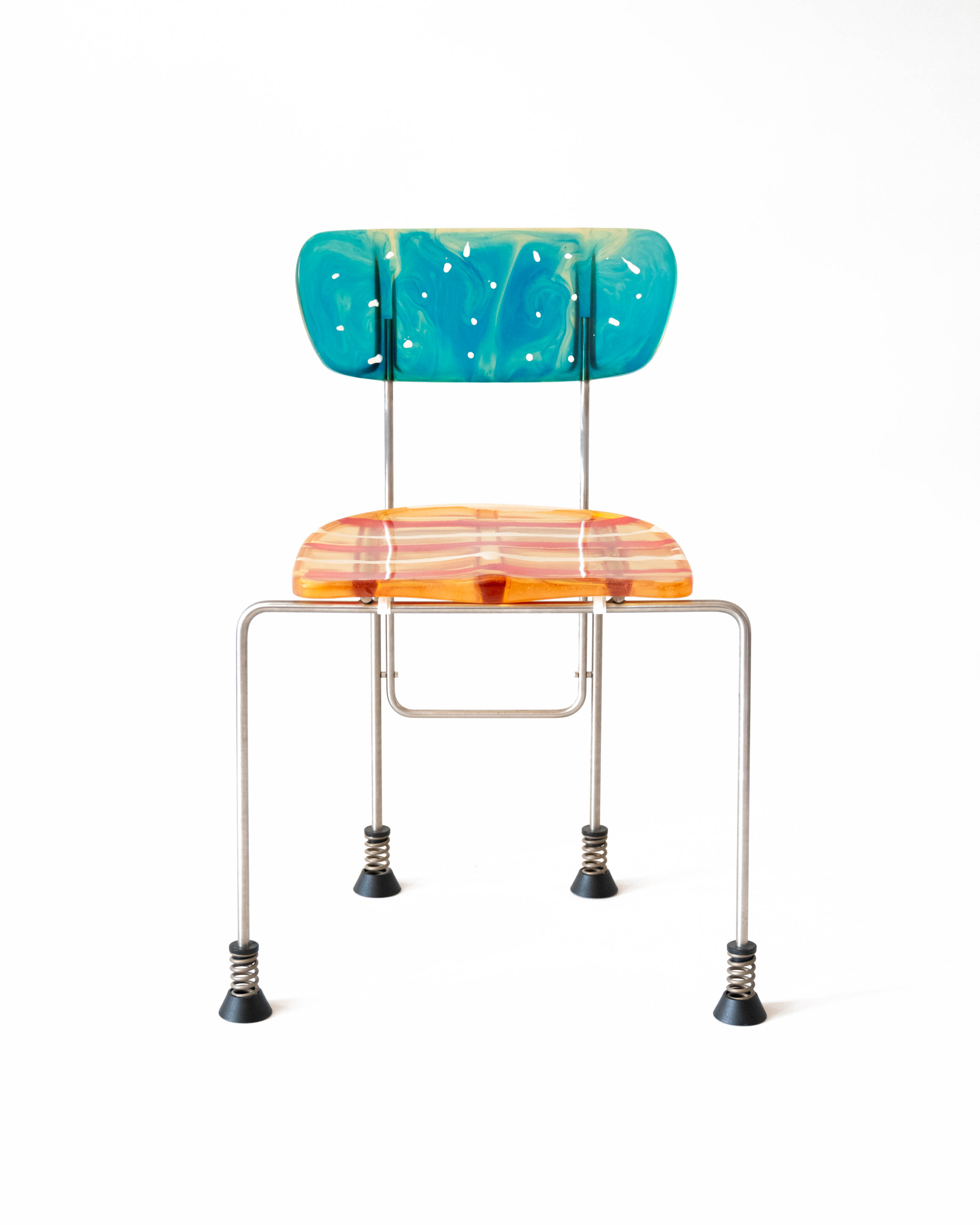
Broadway Chair with Four Legs
Provenance: 9/11 Limited Edition, KaleiThis four legged Broadway chair comes from a limited edition production made by Bernini in tribute to the horrific events of September 11th, 2001. The back features swirling yellow and blue resin as the backdrop for the white drops of ‘stars.’ The seat features white, red, and yellow resin stripes. Together, they create the American flag.
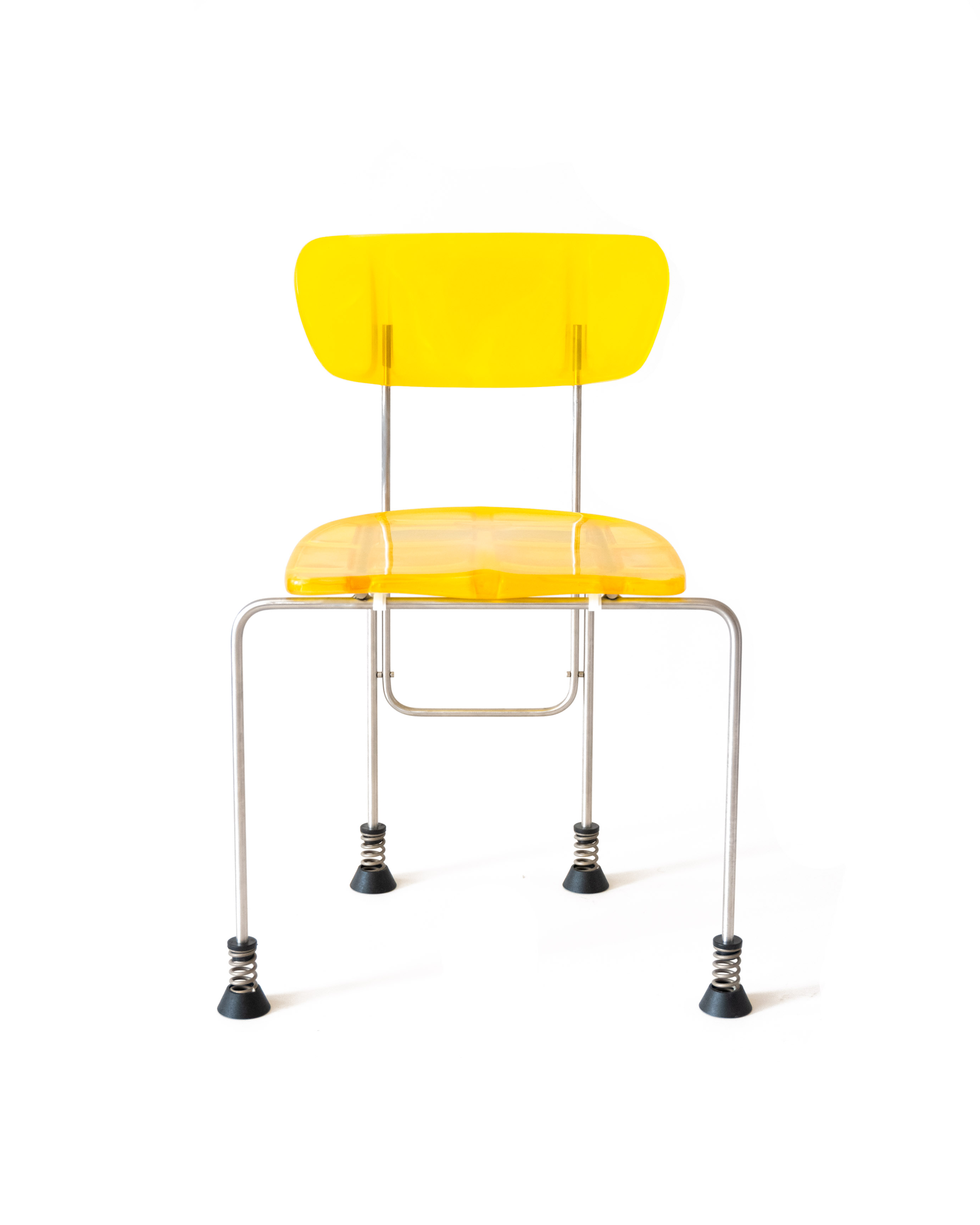
Broadway Chair with Four Legs
Provenance: Limited Edition ‘Extreme Yellow’, KaleiIt is extremely rare for any Broadway chair to be made out of a single color. This limited edition “Extreme Yellow” variation showcases this uncommon phenomenon, made entirely out of a neon yellow color. Over 30 years later, the resin is just as saturated and bright.
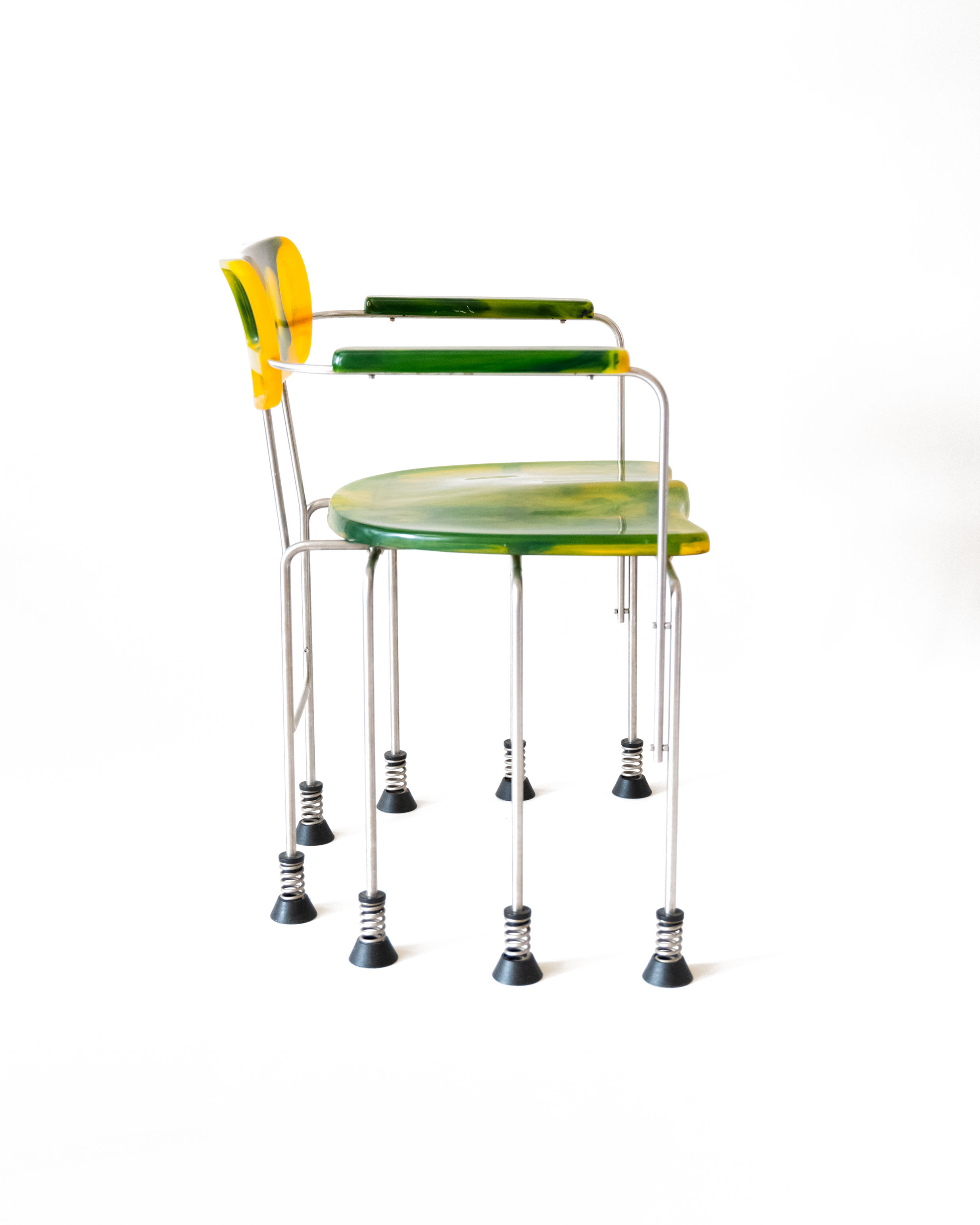
Broadway Armchair with Eight Legs
Gaetano Pesce for Bernini, Italy, c.1993The eight legged Broadway armchair is a unique piece in the Broadway series as it uses a special mold. The seat is wider, thicker, and does not carry the Bernini logo or any markings, as do the seats on the other examples. This is because the mold was made especially for this variations. Courtesy of Kalei.
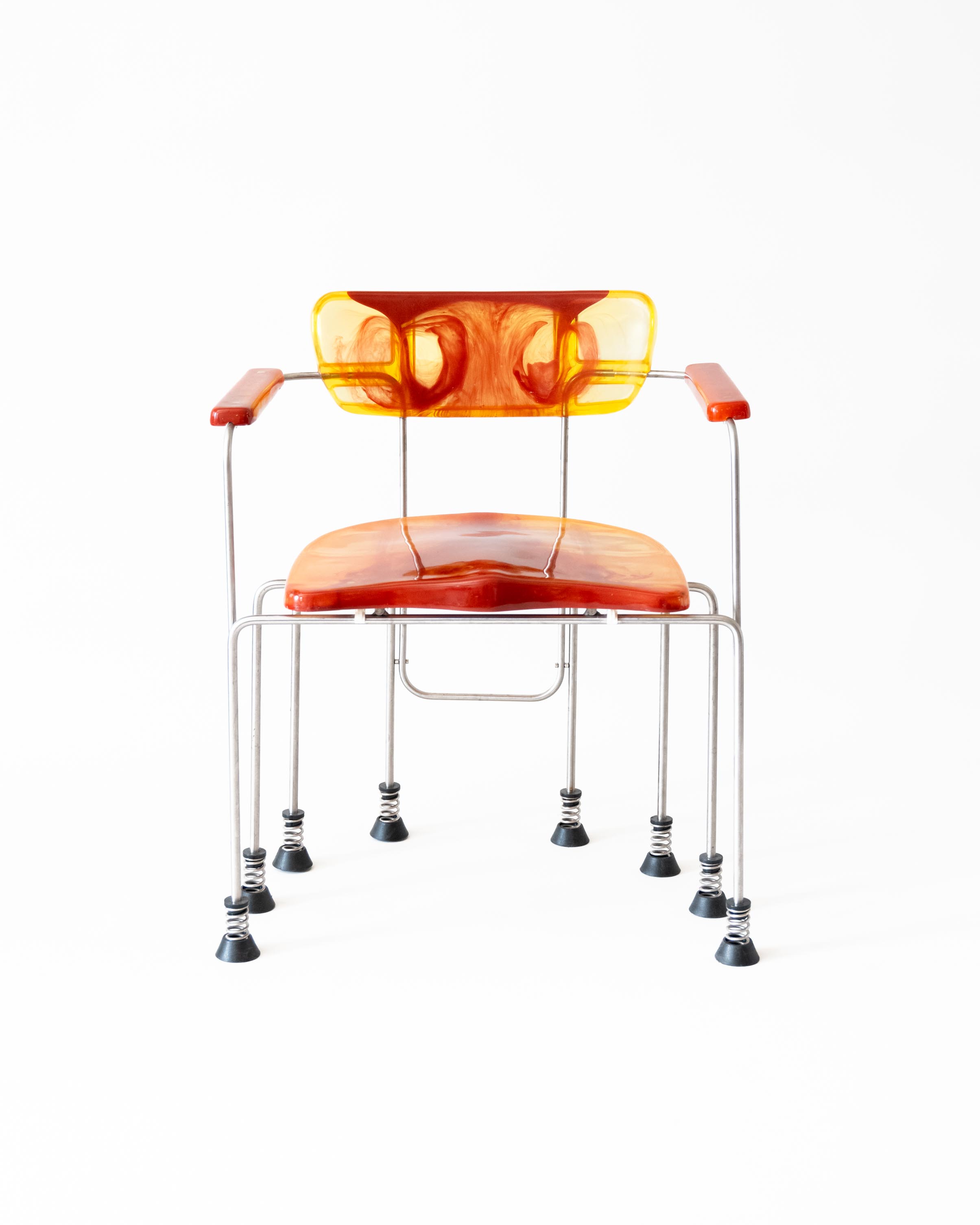
Broadway Armchair with Eight Legs
Gaetano Pesce for Bernini, Italy, c.1993The Broadway Armchair features eight steel legs supported by springed feet. The back, armrests, and seat are all made out of hand-poured resin. Each example is unique, showcasing painterly effects inside of the resin. No two are alike.
More info
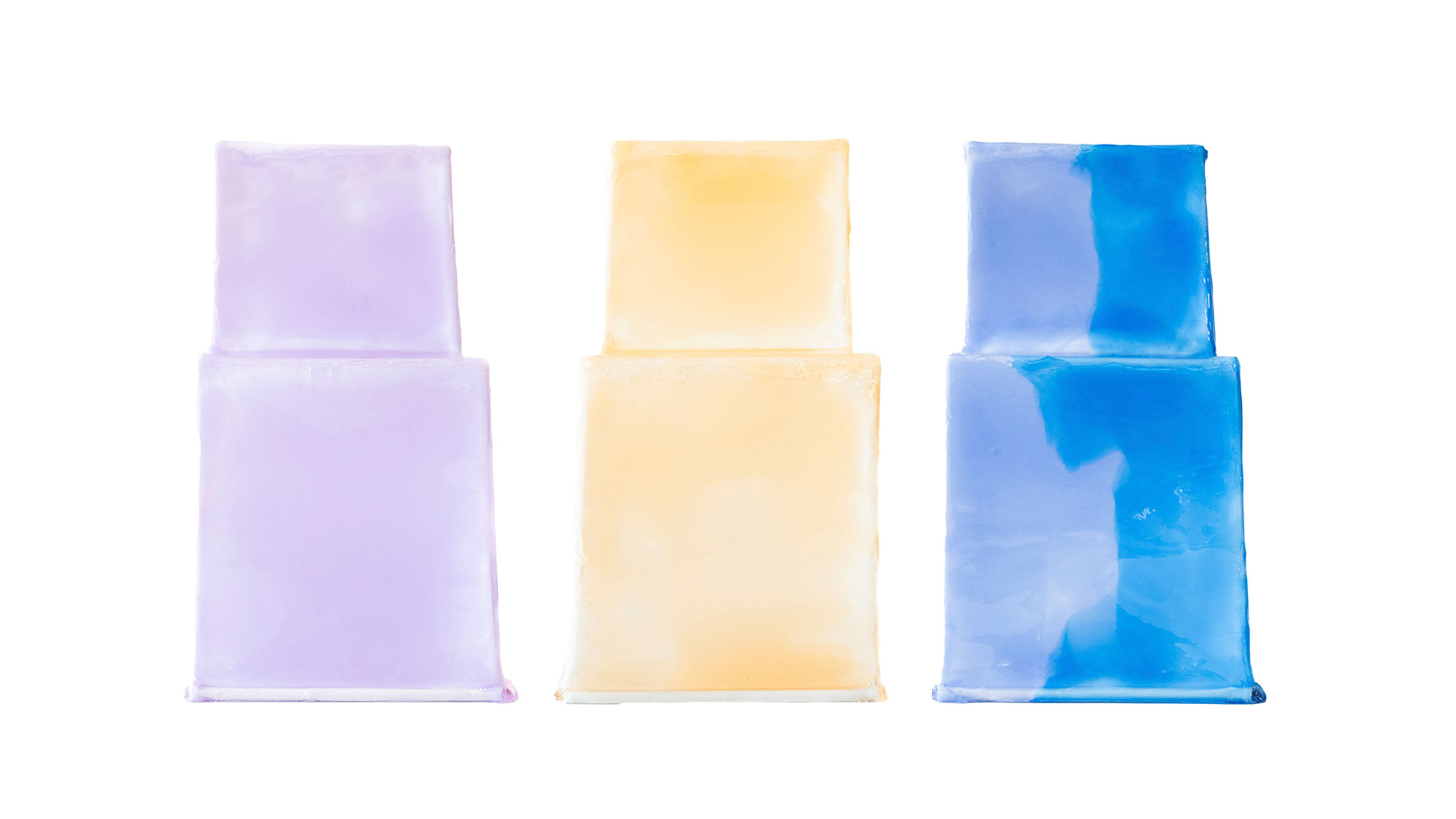
Come Stai? Chairs
Gaetano Pesce for Bottega Veneta S/S ‘23, produced c.2022These chairs come from the series of 400 produced in 2022 for the Spring/Summer 2023 Bottega Veneta fashion show. Gaetano Pesce and his team of assistants created a hand-poured resin floor that became the runway for the models. The 400 chairs were put in the show, sat on, and subsequently sold. Very rare and sought after design. Courtesy of Kalei.
STORAGE
Prototype Face Credenza: In The Office

Pictured is the Prototype Low Face Credenza inside of the 1994 TBWA/Chiat/Day office in NYC. Six different panels each painted unique shades of green make up a face peering back at us. Above, the original black shelving system can be seen.
More info
Prototype Low Face Credenza
Gaetano Pesce for TBWA/Chiat/Day, NYC, 1994This 10 foot long prototype credenza features an all-knowing face which looks at the viewer benevolently. Shades of yellow, green, and blue brushtrokes make up the swirling marks that are very similar to to the gestures seen in Gaetano Pesce’s resin works. This piece is uncommon in that it features lesser-used materials such as wood and acrylic. Very rare, prototype piece.
More info
In The Exhibition: Prototype Face Credenza
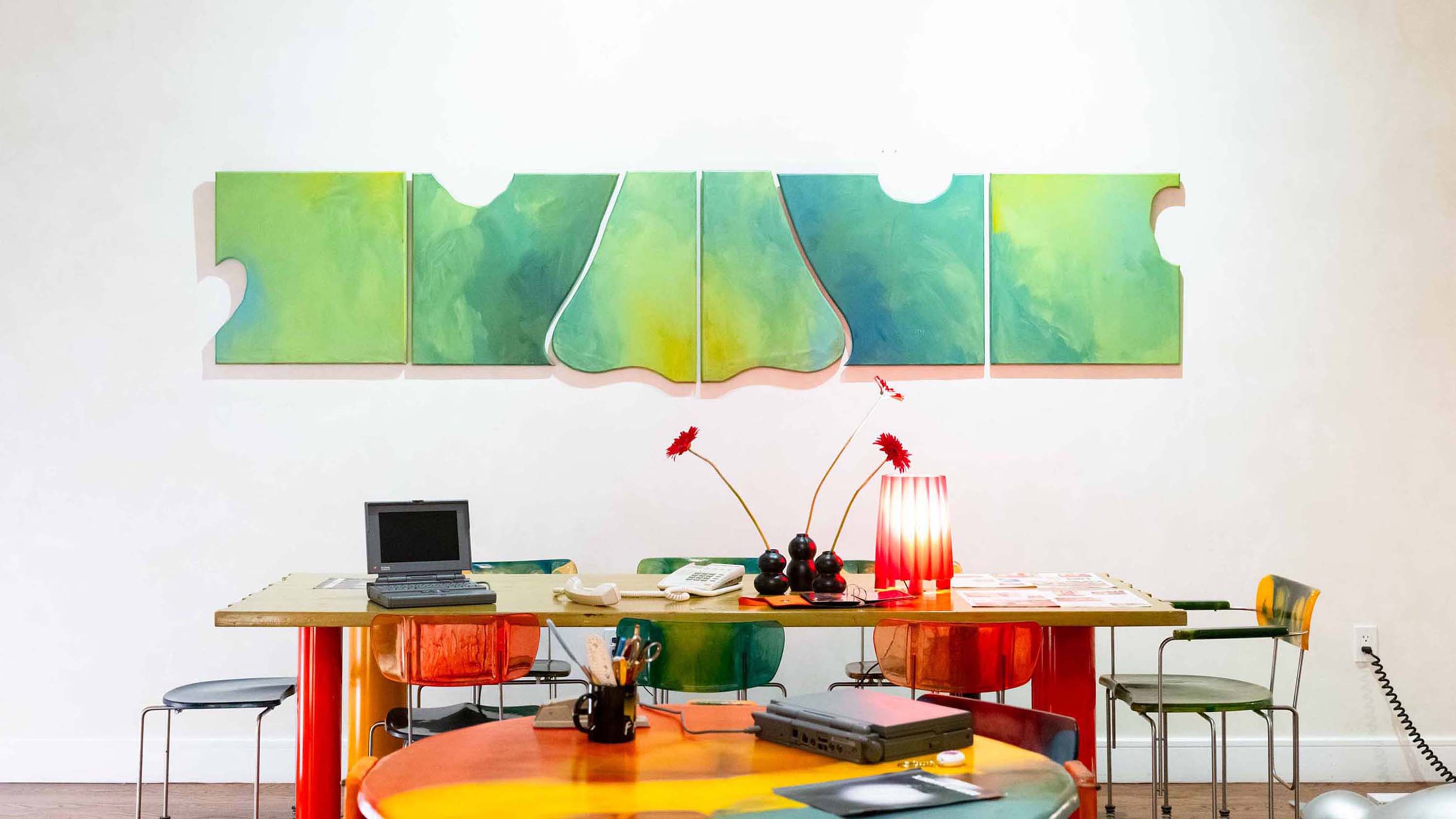
Featured alongside the prototype conference table, Broadway chairs, prototype rubber lamp, and of course the Waffle table from the 1994 TBWA/Chiat/Day project - all designed by Gaetano Pesce.
Rolling Storage Cabinet
Gaetano Pesce for TBWA/Chiat/Day, NYC, 1994It is incredibly uncommon to see straight lines in Gaetano Pesce’s works, as seen in this storage cabinet. This rolling unit features five drawers with organic cutouts highlighted in various hues of contrast colors. The body of the cabinet is painted yellow with the cabinet ‘handles’ outlined in reds, blues, oranges, and greens.
More info
Mail Cabinet
Gaetano Pesce for TBWA/Chiat/Day, NYC, 1994The Mail Cabinet designed by Gaetano Pesce for the 1994 TBWA/Chiat/Day office in NYC. This piece features very subdued colors in comparison to the other bright, saturated pieces seen throughout the office. Perhaps it was because this is where the morning started each day, with the mail, as if a sunrise was slowly emerging into the space.
More info
1999: Working From Home
Here, the TBWA/Chiat/Day Mail Cabinet can be seen ‘working from home,’ saved from the demolition of the office and brought to a safe new home where it lived for a few years until storage.
More info
8ft Sculptural Cabinet
Gaetano Pesce for TBWA/Chiat/Day, NYC, 1994This sculptural cabinet by Gaetano Pesce is a free standing piece constructed from a single door frame taken from the 1994 TBWA/Chiat/Day office in New York City. The organic edge is reminiscent of Nakashima gestures, now painted and turned into an artistic expression. Closed and open, the piece exists as sculpture and utility.
More info
Nobody’s Guard Bookcase
Gaetano Pesce for Zerodisegno, c.2003The Nobody’s Guard Bookcase by Gaetano Pesce is a ceremonial storage unit offering fuction and form. Shifting impressions rather than fixed reflections are offered from the mirror - the circular fun-house-like reflections are a play on expectation and the contrasting red/ black colorations along with the two horns on the top seem to echo a spirit or entity behind them.
More info
LIGHTING

Antonucci Cafe Resin Chandelier,
Gaetano Pesce for Antonucci Cafe, NYC, c.2022When Francesco Antonucci, the owner of Antonucci Cafe in NYC, came to see this pendant in real life he told me, “Your pendant? It is more beautiful than all of the pendant’s in my restaurant.”
While I don’t agree with him, I greatly appreciate the kind words...
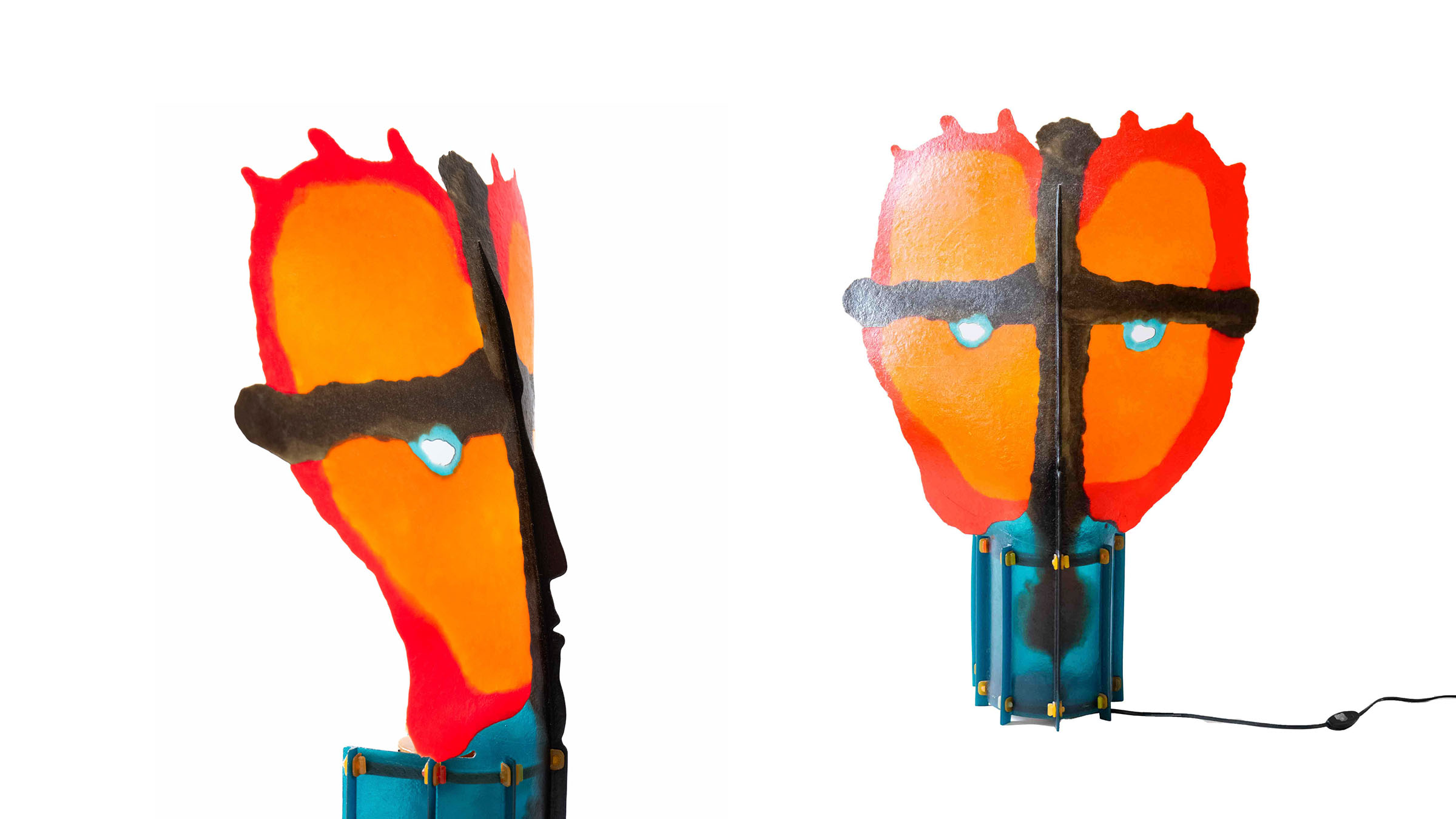
Some Of Us Lamp
Gaetano Pesce c.2000, edition of 20The Some Of Us Lamp by Gaetano Pesce comes from an edition of only 20 examples, featuring a silhouette which changes as you move around it - much like a human face there is a front profile and also a side profile. An upwards and downwards facing bulb illuminates the resin from behind, casting a strong glow and presence. Courtesy of Kalei.
Olo Lamp
Gaetano Pesce for Galleria Modernariato, Milan, c.2000The Olo lamp features a heart shaped face that looks back at you. To some it may appear to be a monster, or others a fairy - maybe something in between. Either way, it is a reminder of the imperfection in life, with bits of pieces missing from the edges of the heart. Numbered and signed by Gaetano Pesce from the edition of 100 made for the Milan Galleria Modernariato in 2000.
More info
Moss Lamp
Gaetano Pesce for Murray Moss c.2000The Moss Lamp was designed by Gaetano Pesce as a special gift for Murray Moss and his partner Franklin Getchell for the 1999 opening of their second showroom opening in NYC. The lamp has since been reissued by Meritalia in a small production, however this examples is an early production version featuring a much more flexible resin structure in addition to a larger and slightly different shape.
More info
Moonshine Lamp
Gaetano Pesce c.2000Designed in 1999, Gaetano Pesce’s Moonshine Lamp showcases the symbol of a luminous, sculptural moon that glows infinitely. Tiny bits of paper-thin resin make up the outer material of this otherworldy object.
More info

Prototype Vase/Lamp
Gaetano Pesce prototype, c.2022This prototype lamp was originally designed by Gaetano Pesce as a vase. Circa 2022, Pesce decided it was meant to become a lamp. Thus he turned the lamp upside down, fixed three different sized feet to the bottom, welded an internal steel structure to hold the wiring, and the vase became a lamp. This is an extremely rare prototype piece serving as an example to Pesce’s often random, serendipitous, and always experimental practice.
More info
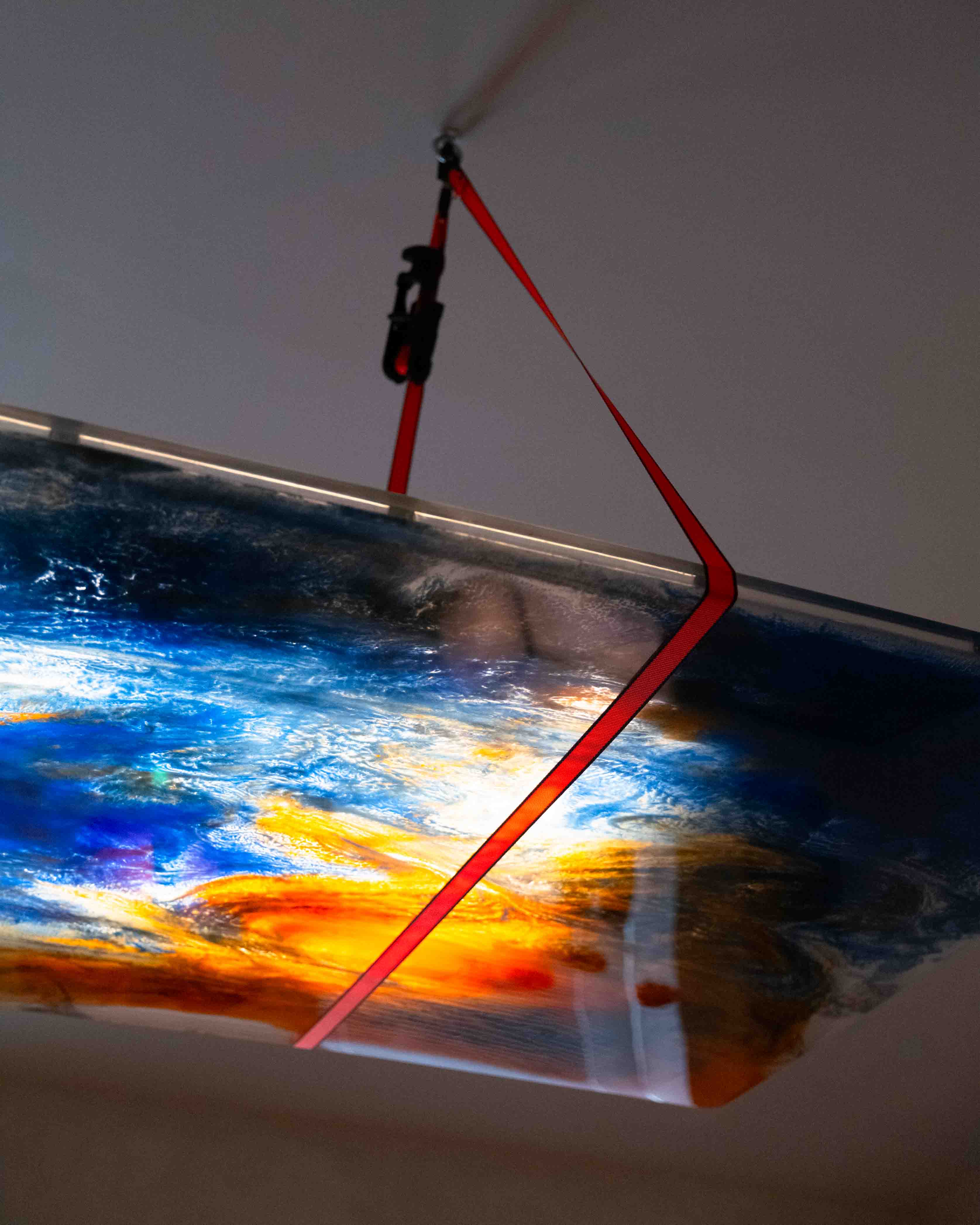
Broadway Chandelier
Prototype, Sweeterfat construction 2025Inspired by the prototype vase/lamp that Pesce made, this Broadway table from the 543 Broadway series was repurposed as part of the Work/Life Imbalance Exhibition to become a chandelier. Combining utility with sculpture, the table was turned upside down, its legs were removed (an ode to the prototype rubber lamp), and it became a lamp, too.
More info
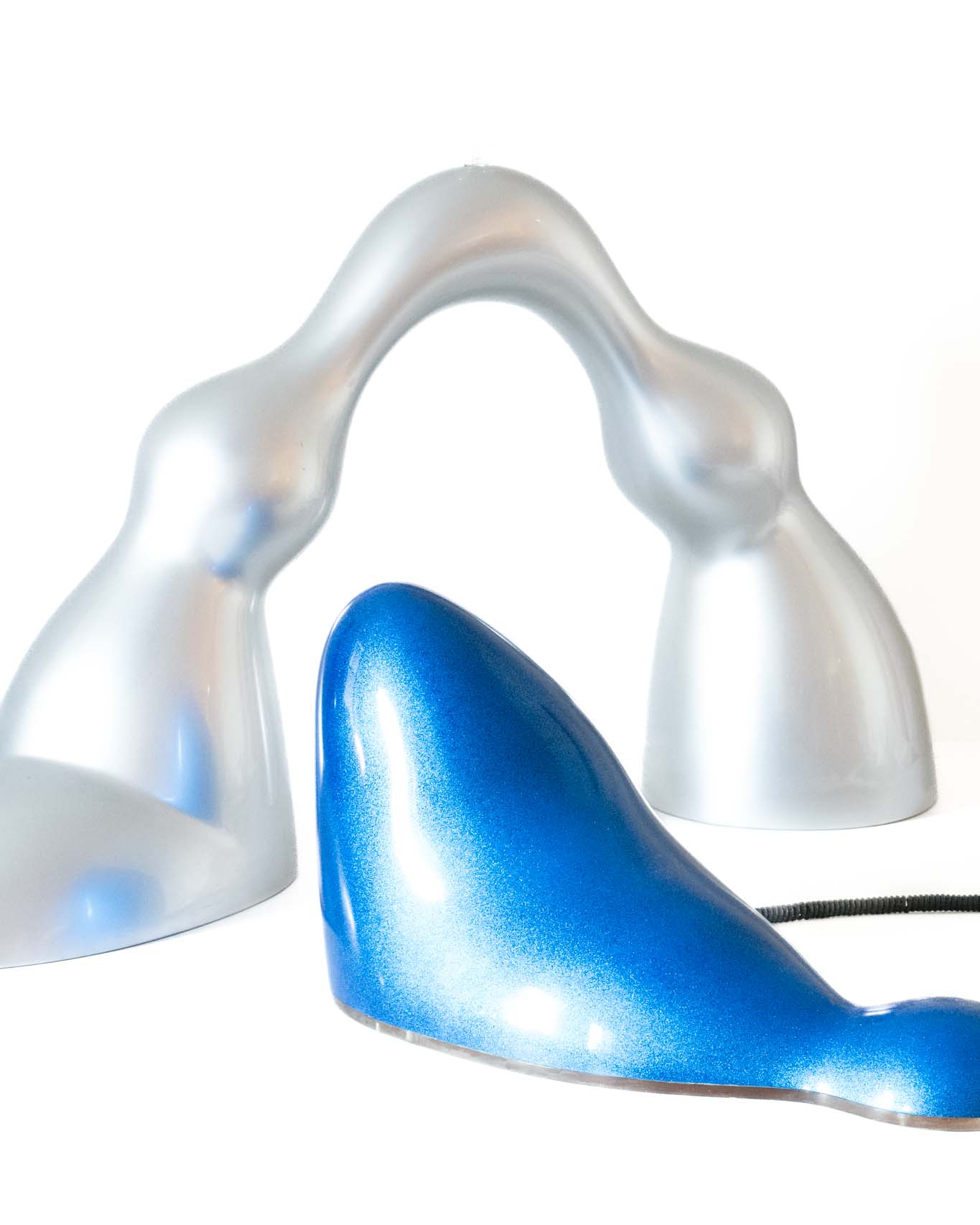
‘Fat Albert’ & ‘Sluggo’ Lamps by Wendell Castle
Wendell Castle, 1969These two lamps designed by Wendell Castle in 1969 are examples of anthropomorphic design and avant-garde use of materials decades before the 1994 TBWA/Chiat/Day office existed. Different in style and scope, they are included in this recreation of the office because Pesce himself used others’ designs in the space - so this is our choice for an appropriate inclusion. The blue lamp is named ‘Sluggo’ and the silver lamp is named ‘Fat Albert.’
More info
OTHER
Resin Outlet Cover: In The Office
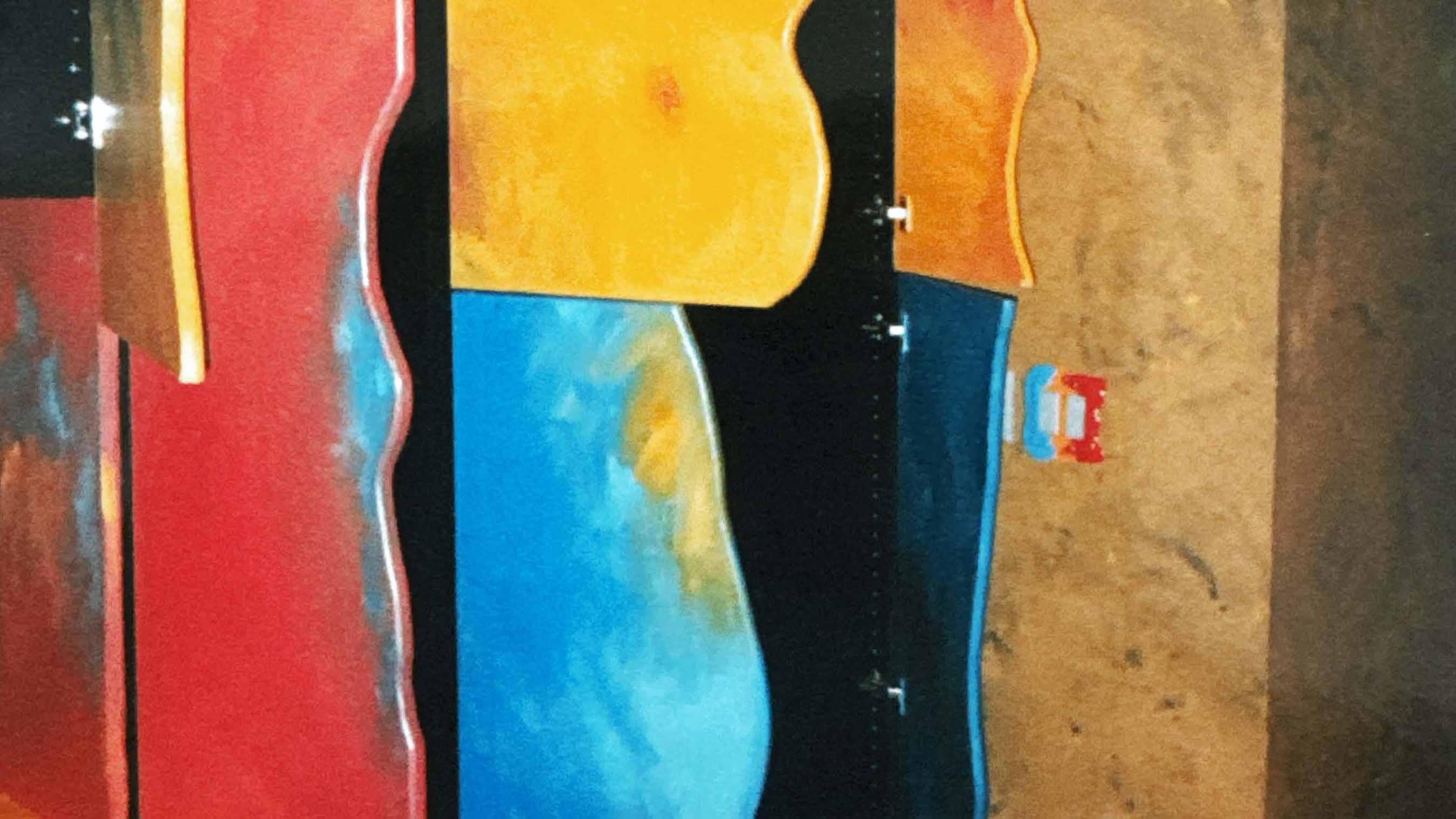
Pictured above is a closeup of the resin outlet cover from Gaetano Pesce’s 1994 TBWA/Chiat/Day office in NYC. It is unknown how many of these resin covers were made or if this is the only one. Per our research, this is the only example to have survived the closing of the office and subsequent demolition of the space. Also pictured are the cabinet doors in situ, lots of colors and no straight lines.
Resin Outlet Cover
Gaetano Pesce for TBWA/Chiat/Day, NYC, 1994The resin outlet cover shows that Gaetano Pesce’s color and playfulness can be used even in the smallest of places, perhaps especially here. The mold is taken from a standard Leviton outlet cover, an ordinary object used to create a piece of functional art.
More info
Sliding Glass/Wood Figurative Door
Gaetano Pesce for TBWA/Chiat/Day, NYC, 1994This monumental prototype door from the TBWA/Chiat/Day office shows an array of colors and shapes, offering a portal to the next room.
More info
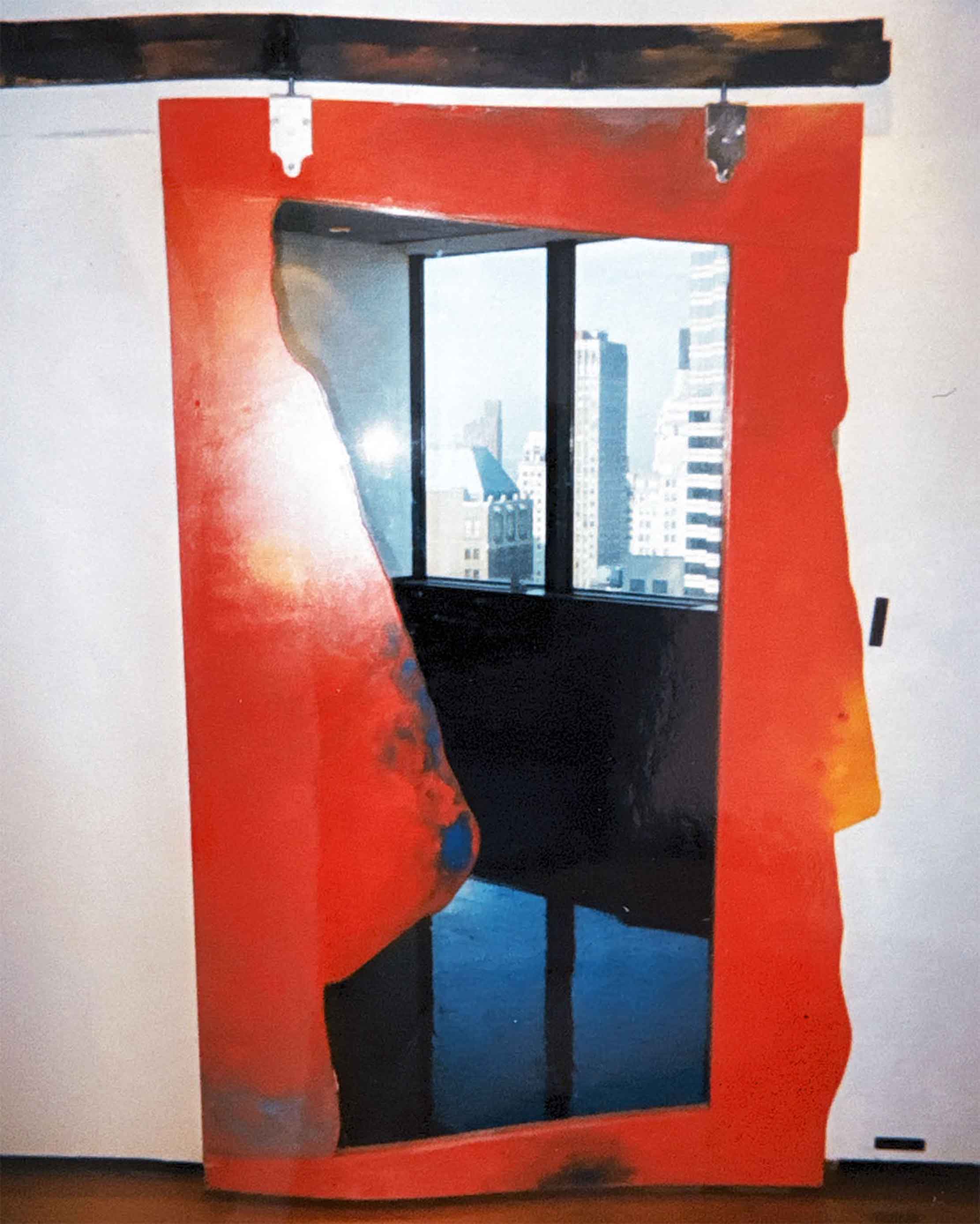
1998: In The Chiat/Day Office
The sliding door can be seen here in its original placement, attached to a thick wooden beam which acted as a track for it to slide on. The door is extremely heavy - over 500lb - featuring thick wooden panels and a large glass insert.
More info
Brown Door
Gaetano Pesce for TBWA/Chiat/Day, NYC, 1994Hand constructed Brown Door designed by Gaetano Pesce for the 1994 TBWA/Chiat/Day office in NYC. A four-panel window frame cutout is the only interruption to an otherwise straight lines, normal door form. The colors are reminiscent of the soil, the earth, and nature.
More info
‘Scream 1 & 2’ Cabinet Door Reliefs
Gaetano Pesce for TBWA/Chiat/Day, NYC, 1994Cabinet doors designed by Gaetano Pesce in 1994 for the TBWAChiatDay offices. Painted in bright yellows and oranges, the panels feature rounded cutouts and irregular silhouettes - more characters than cabinets. When paired, faces appear with their mouth’s ajar in what may be yawns, discussions, or screams.
More info
Resin & Steel Desks
Gaetano Pesce for TBWA/Chiat/Day, NYC, 1994Resin and steel desks by Gaetano Pesce for the 1994 TBWA/Chiat/Day office in NYC. A combination of fluid and rigid materials to create a functional piece that can also be used as a wall relief. The resin on each example is different, creating painterly effects cast across the steel grid structure. Three total examples available.
More info
In The Exhibition: Resin & Steel Desk by Gaetano Pesce
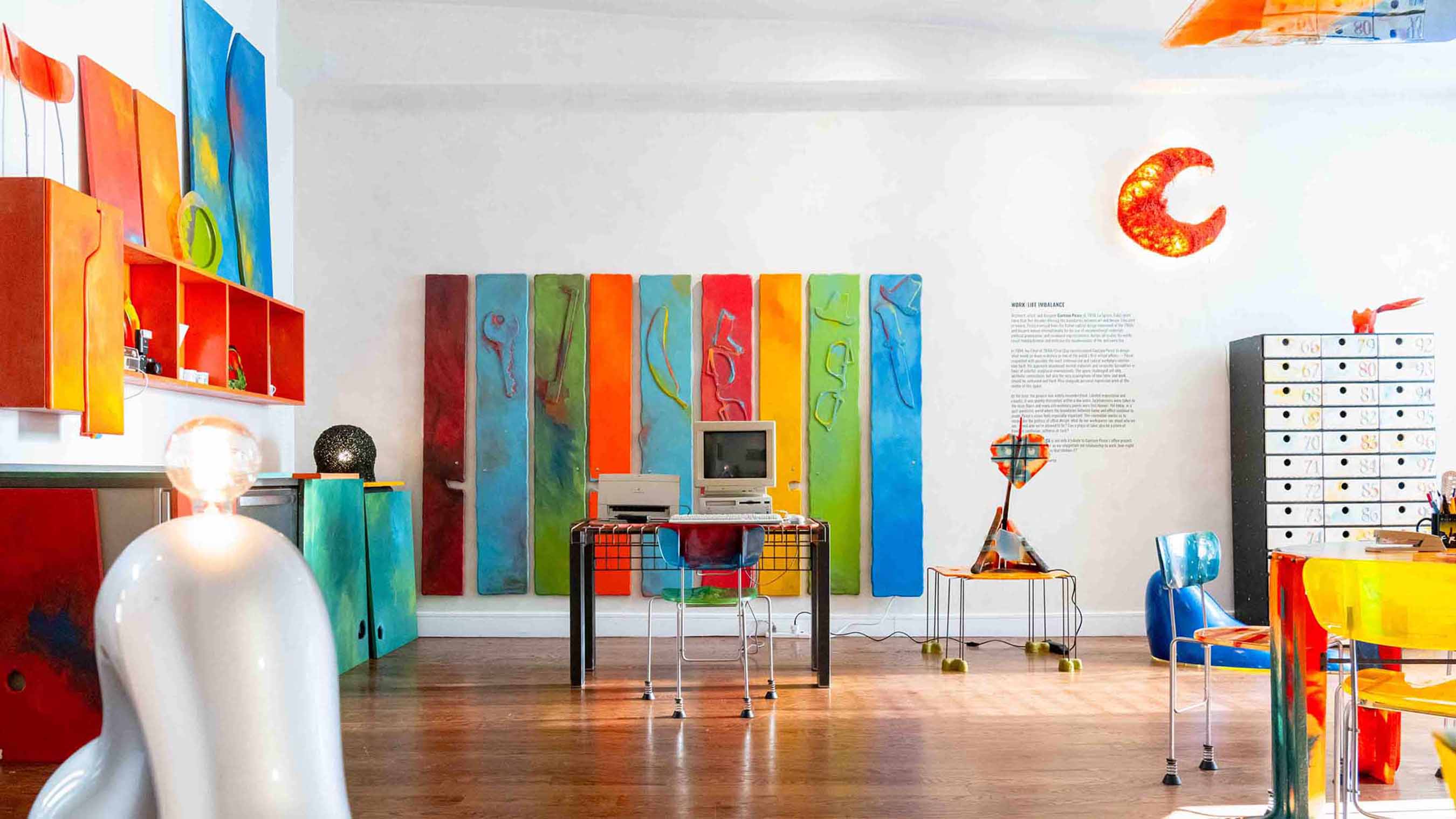
Pictured above is the assembled resin & steel desk designed by Gaetano Pesce for the 1994 TBWA/Chiat/Day NYC headquarters. Photographed alongside other pieces from the office, as part of the Work/Life Imbalance exhibition curated by Sweeterfat in collaboration with Kalei.
Face Locker Doors
Gaetano Pesce for TBWA/Chiat/Day, NYC, 1994These locker doors were the only place in the office where an employee had an assigned space - otherwise there were no assigned desks or offices. As a center point, Pesce made these lockers reflect personalities back onto the users, a rare moment of humanity in workplace design.
More info
Symbolic Locker Doors
Gaetano Pesce for TBWA/Chiat/Day, NYC, 1994These locker doors feature unique symbols, alone and sometime paired together. In classic incoherence, there are canes alongside rollerblades and also toothbrush lockers next to suit lockers. This was once again the only place in the office where an employee had an assigned space - otherwise there were no assigned desks or offices. The front and backs are painted independently of each other, with slight variations in color and design.
More info
‘Open Mouth’ Locker Doors
Gaetano Pesce for TBWA/Chiat/Day, NYC, 1994These locker doors feature unique symbols, alone and sometime paired together. In classic incoherence, there are canes alongside rollerblades and also toothbrush lockers next to suit lockers. This was once again the only place in the office where an employee had an assigned space - otherwise there were no assigned desks or offices. The front and backs are painted independently of each other, with slight variations in color and design.
More info
Locker Doors: In The Office
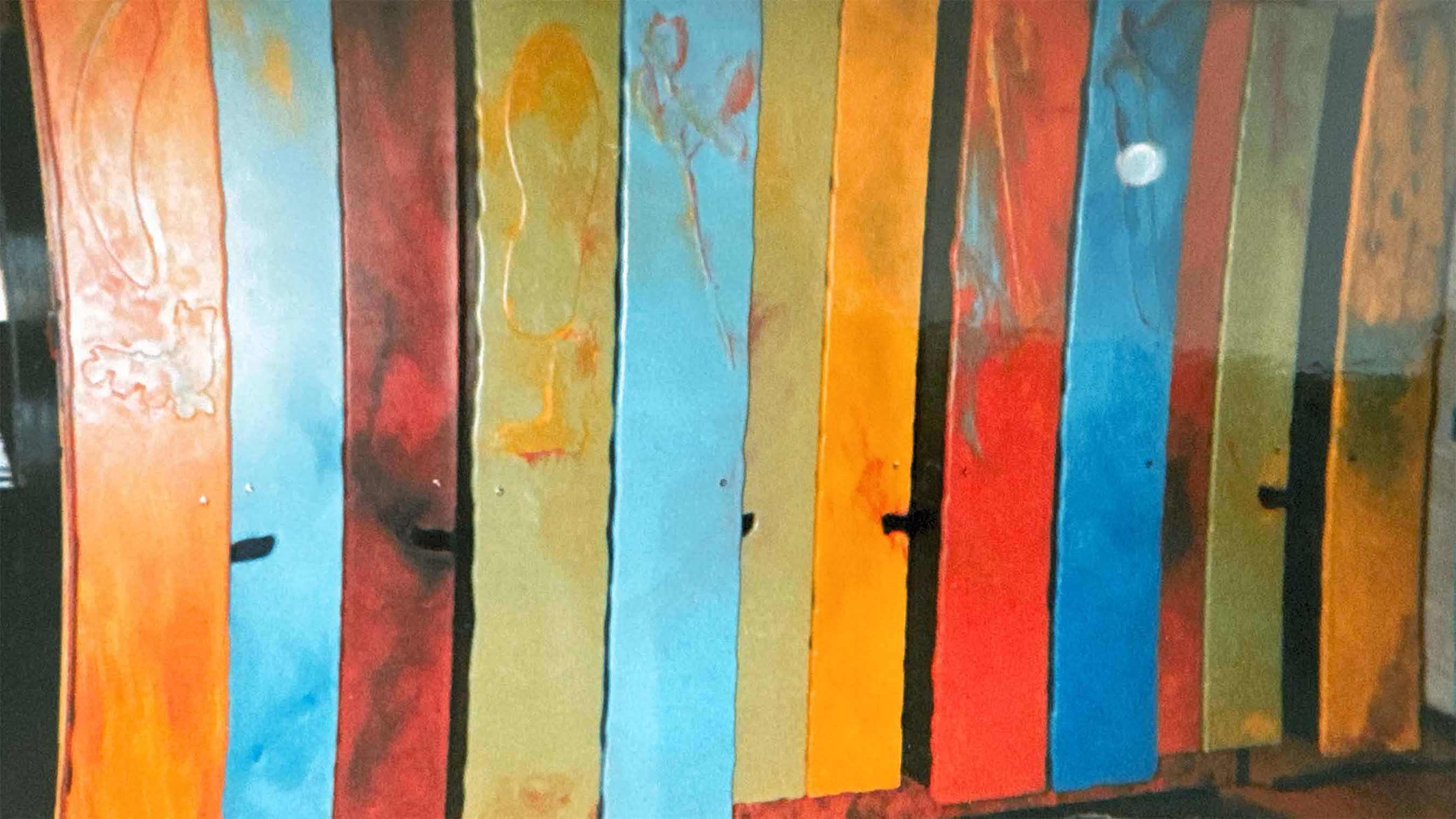
Pictured above are the symbolic locker doors designed by Gaetano Pesce for the 1994 TBWA/Chiat/Day office in New York City, 1994. They featured extremely colorful designs with various symbols and faces hidden throughout. Unlike the other areas of the office which were unassigned spaces, these lockers were a rare occurrance of personal space in an otherwise incredibly communal environment. In the middle, there is the one of one “Rose” locker door, featuring the symbol of a rose set against a bright blue background.
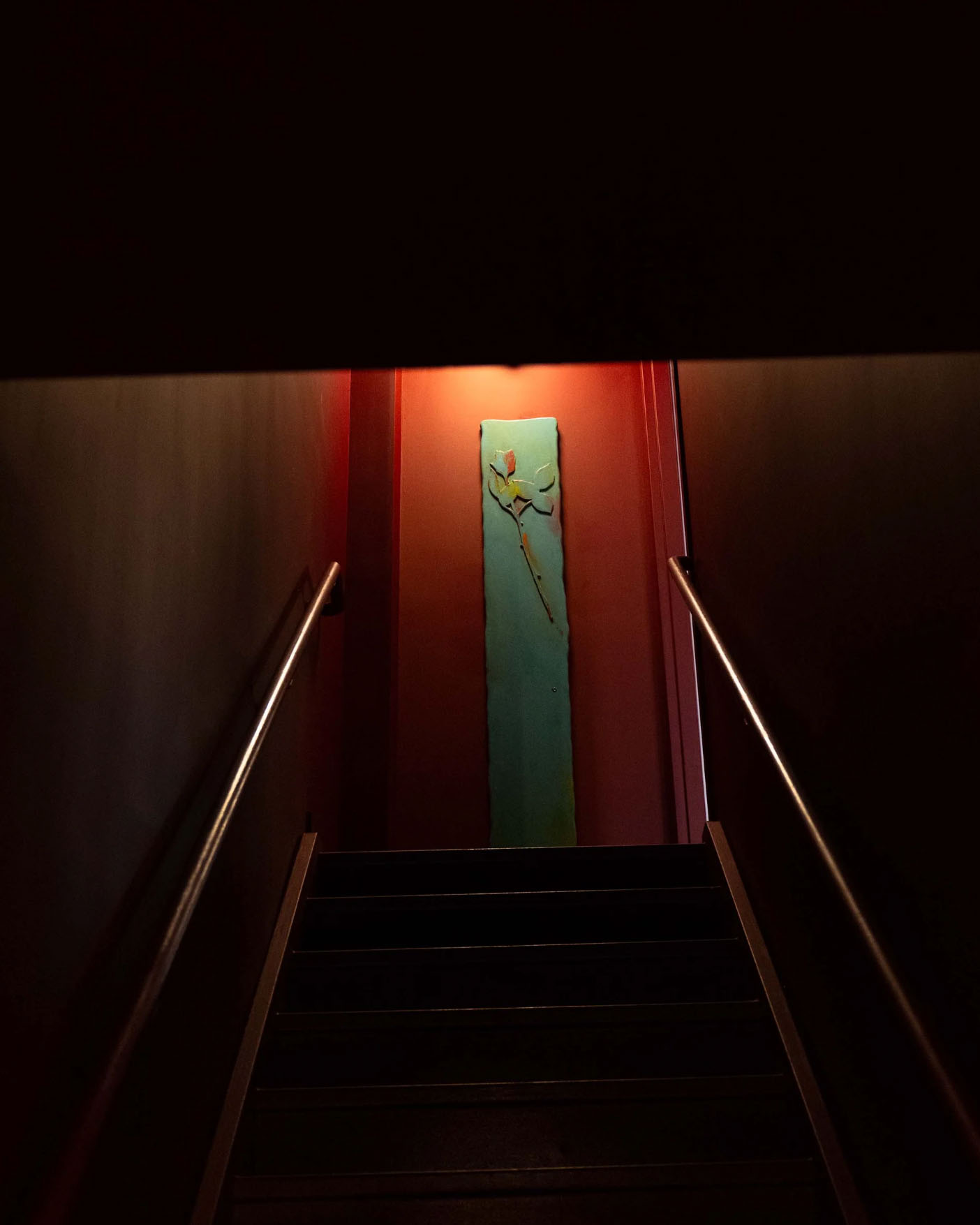
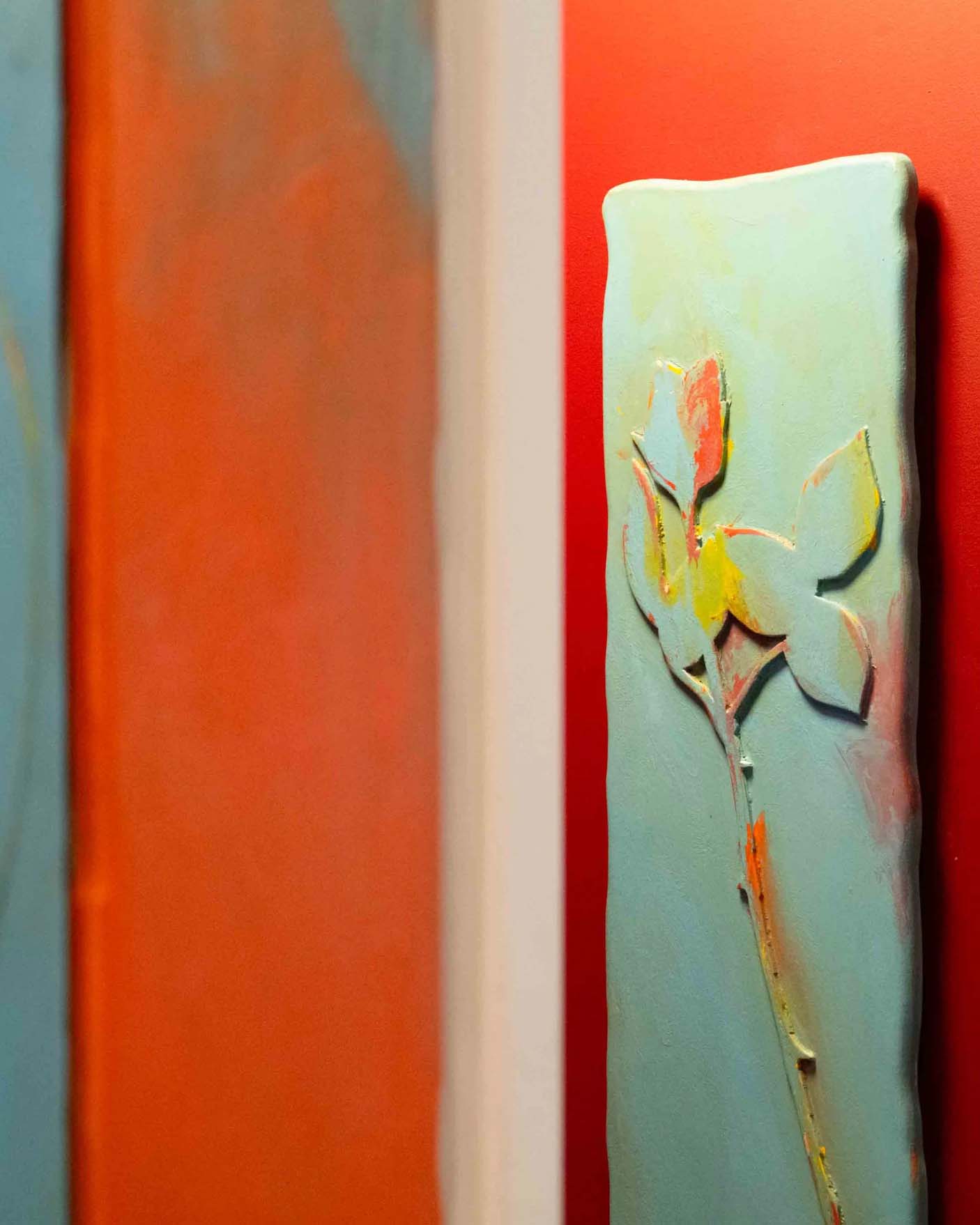
TBWA/Chiat/Day “Rose” Symbolic Locker Door
Gaetano Pesce for TBWA/Chiat/Day, NYC, 1994Among all the locker doors designed by Gaetano Pesce for the 1994 TBWA/Chiat/Day NYC headquarters, only one bears a rose. It is a poetic anomaly in a sea of abstract forms, standing out as the crown jewel of the locker doors.
It may make little sense for this caring motif to exist in a corporate setting, however by now you will understand, surely, that for that reason alone it makes perfect sense.
More info
Hello@sweeterfat.com
Brooklyn, NY
Art & Design
Worldwide shipping available

